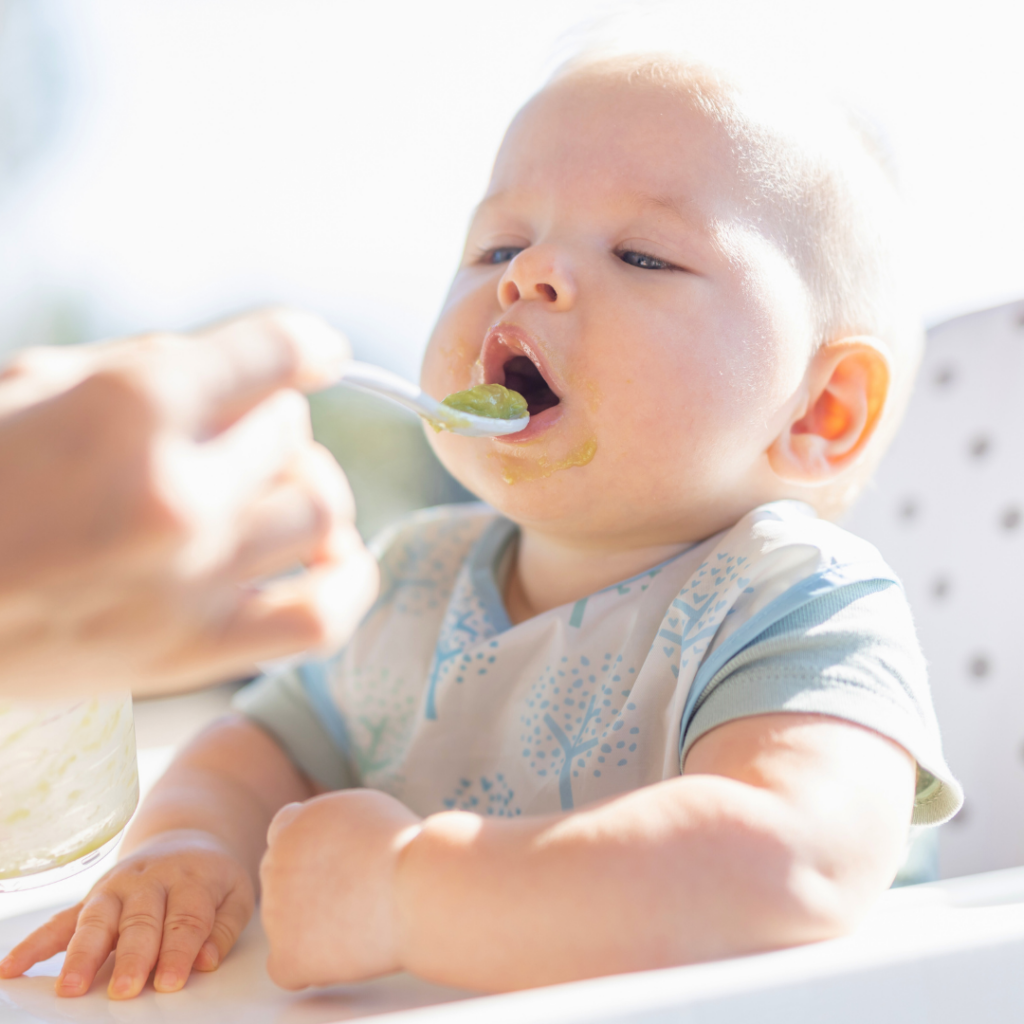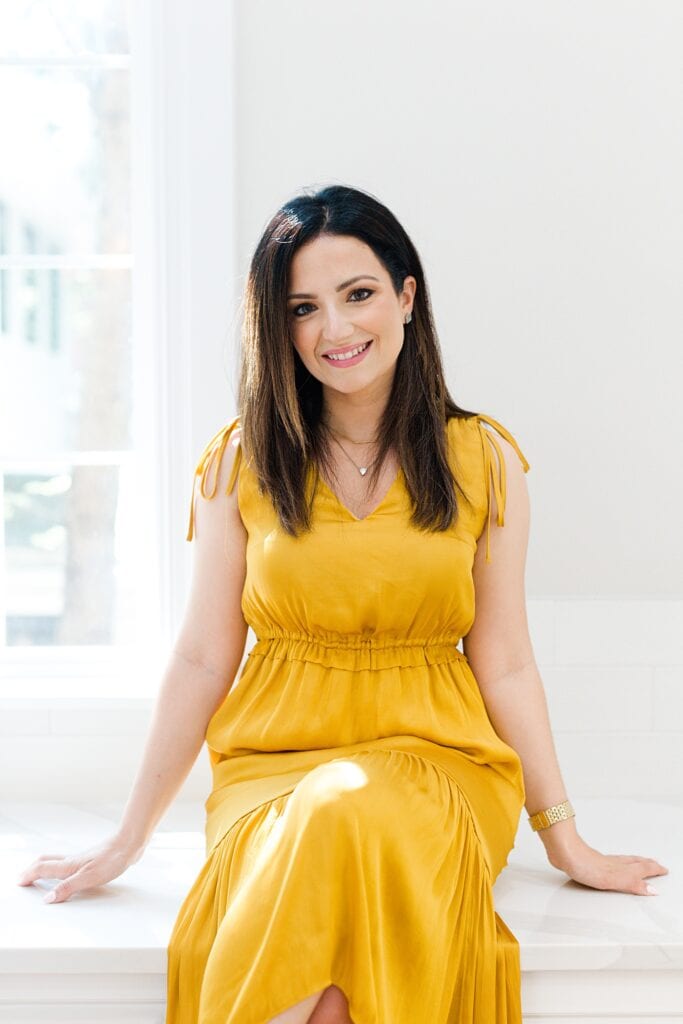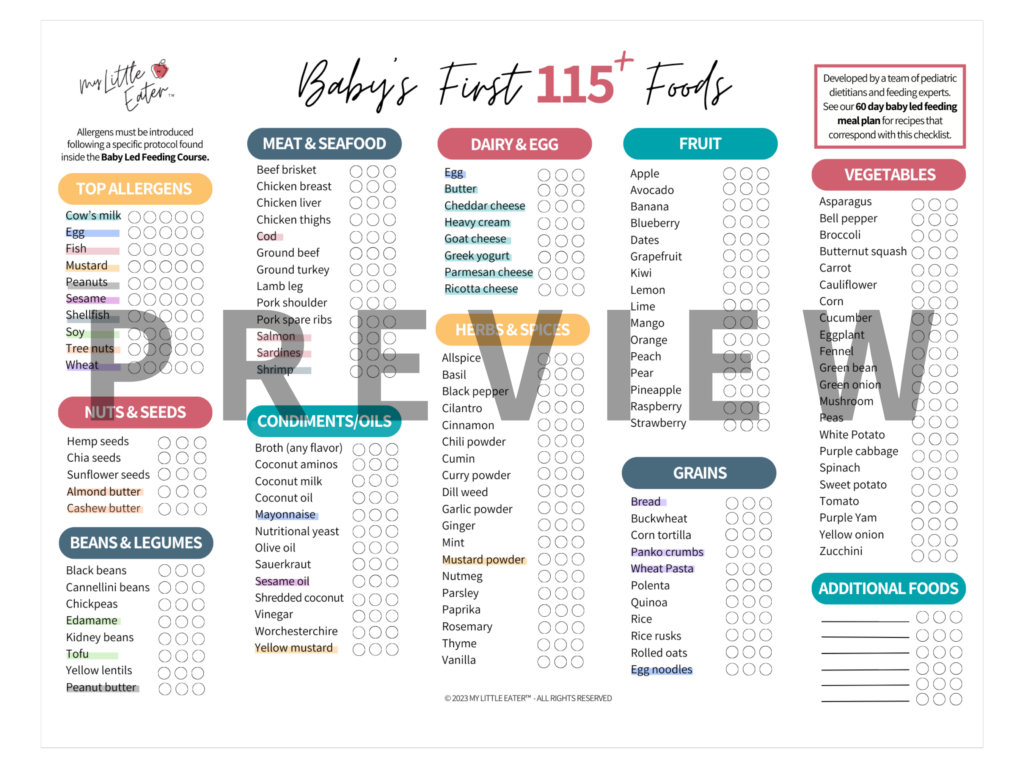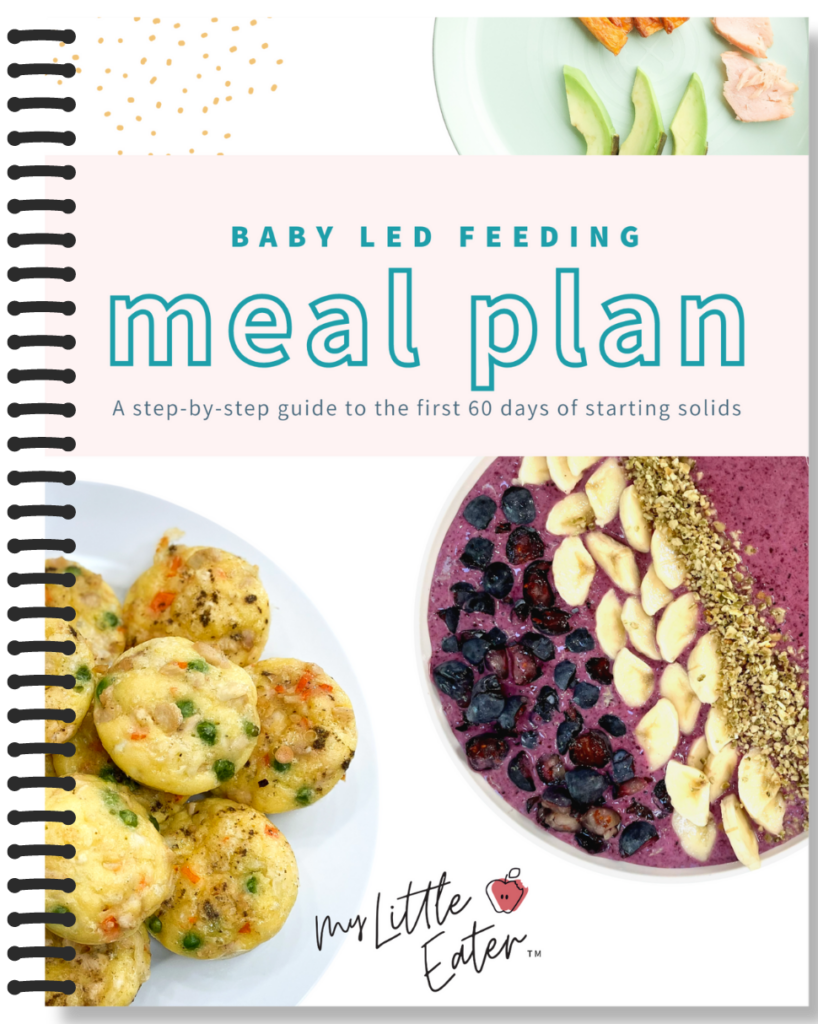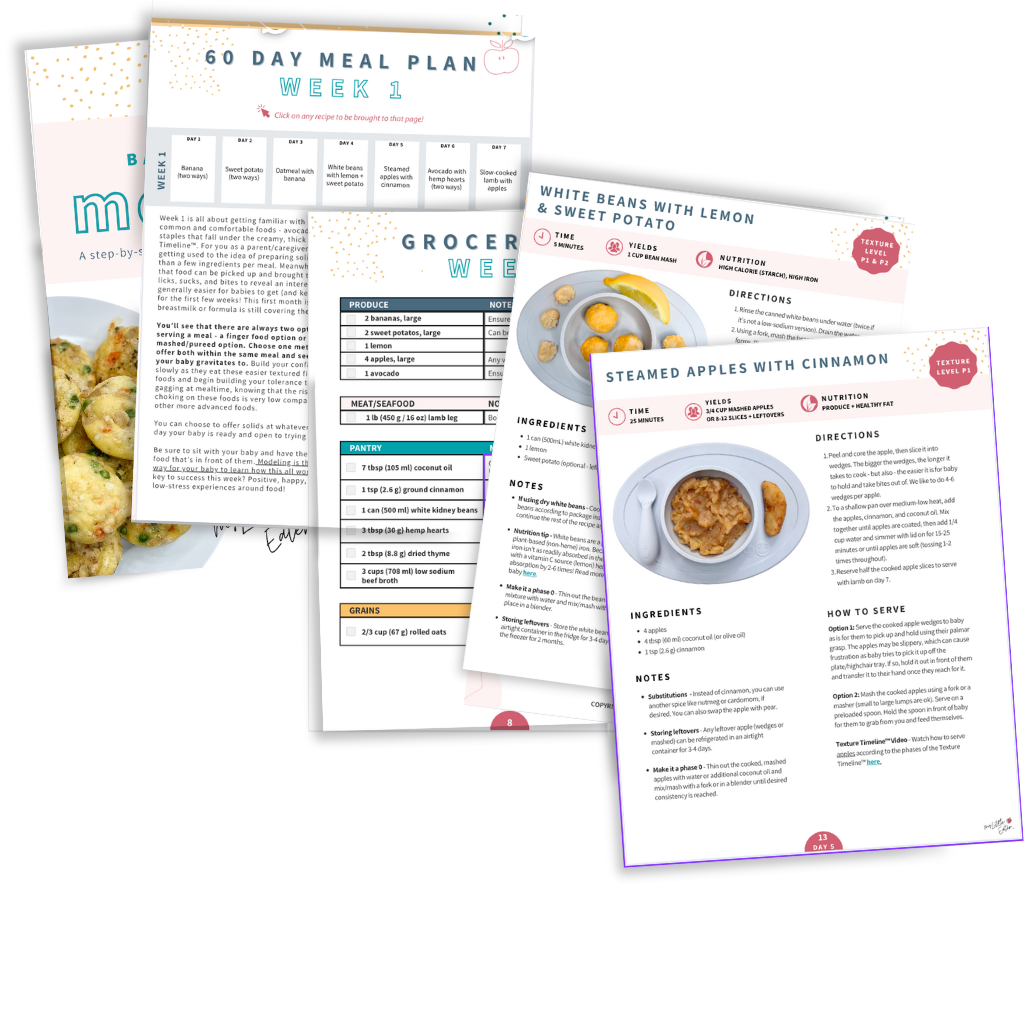- No Comments
- Edwena Kennedy, RD
This post may contain affiliate links, please view our disclosure policy for more details.
You’re Googling best high chair or best baby high chair, but the options seem endless, the features vary wildly, and the price points range from budget to high-end.
And choosing the right high chair for your baby isn’t just about price or convenience — it’s about safety, development, and creating a positive mealtime environment. As pediatric dietitians and feeding experts, we’ve worked with thousands of families navigating this exact decision, and we know how overwhelming it can be.
This guide will help you confidently choose the best high chair for your baby based on criteria that matters as feeding experts and as moms. We’ve sifted through the most popular chairs to determine which have features are necessities and which ones are just nice-to-haves. We also discuss why proper posture high chairs with adjustable footrests are critical for feeding success, and share our top recommendations based on real-world testing and the latest safety/ergonomic research.
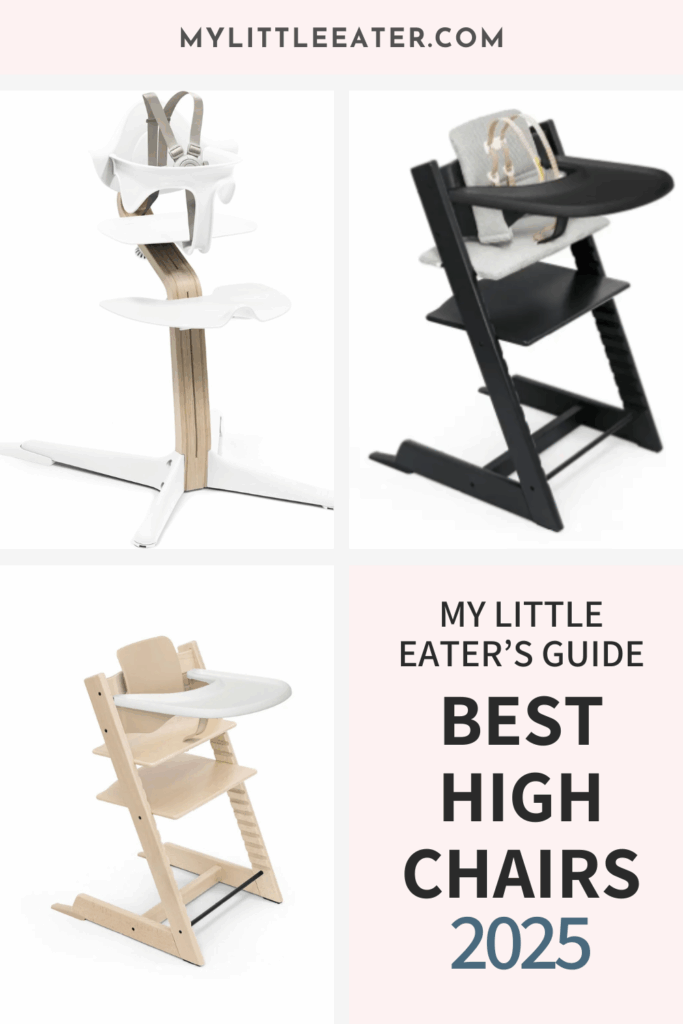
Table of Contents
What to Look for in a High Chair
Here is the criteria we look for (as pediatric feeding experts) when ranking best high chairs:
1. Supportive for Baby's Posture + Safety
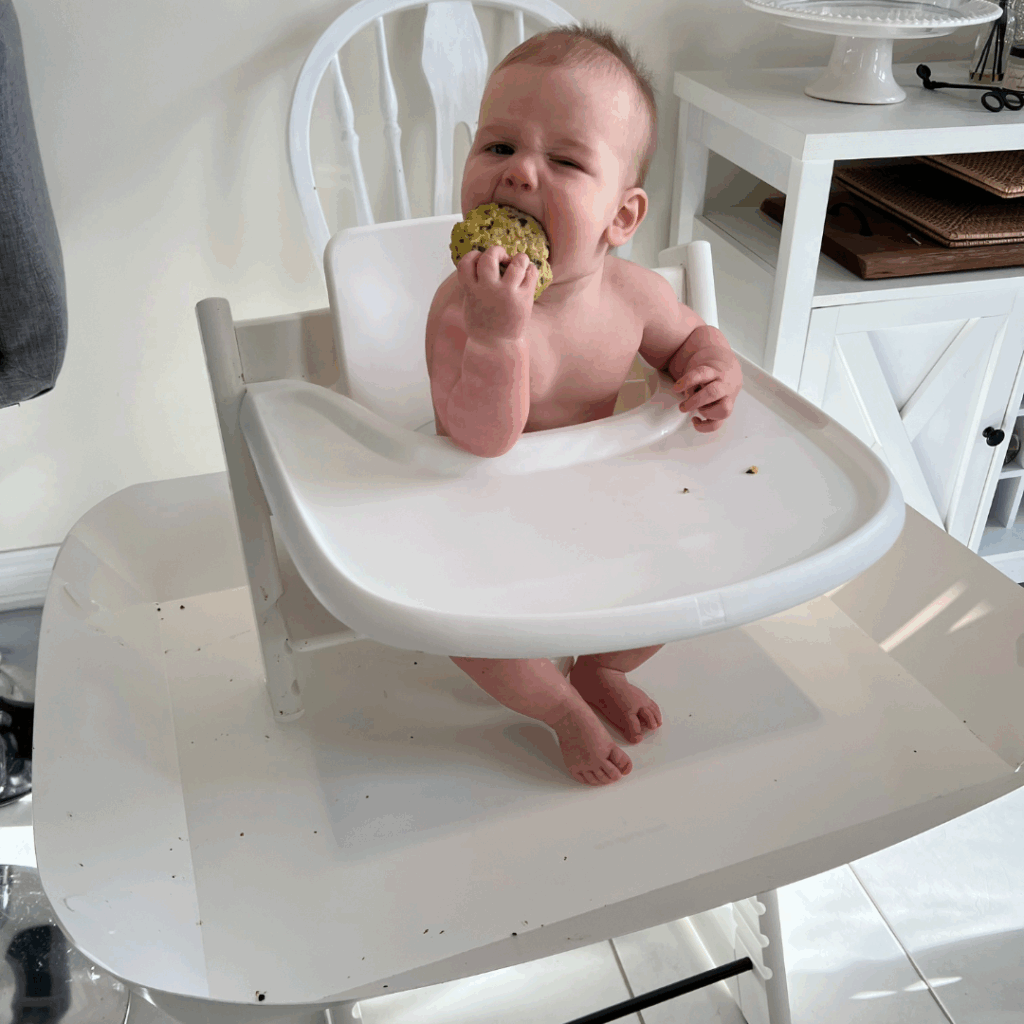
- Adjustable footrest: Essential for supporting baby’s feet flat and grounded (helps prevent fidgeting, improve attention at meals). Footrests provide comfort by allowing babies to rest their feet, preventing strain on their core muscles.
- Supports the 90-90-90 posture: Baby sits with hips, knees, and ankles are at positioned at 90° angles to allow for proper support, stability and feeding skill development.
- Fully upright seat: No recline (shoulders should sit directly over the hips) – unless perhaps you are bottle feeding in this position. This encourages safe swallowing and independent eating.
- Adjustable seat depth: Helps align baby’s back and thighs for proper posture, especially as they grow. Baby has room to lean slightly forward if they choose, while still being supported.
- Adjustable tray or table-height compatibility: Tray should sit just below baby’s elbows, which allows freedom of movement for self-feeding (on purees or finger foods)
- Five-point harness: A five point harness (meaning it has shoulder straps, hip straps and crotch strap) keeps baby secure and reduces the risk of falls. Always use the full harness/safety strap — falls from high chairs are a major cause of injury among young children.
2. Practical + Easy to Use
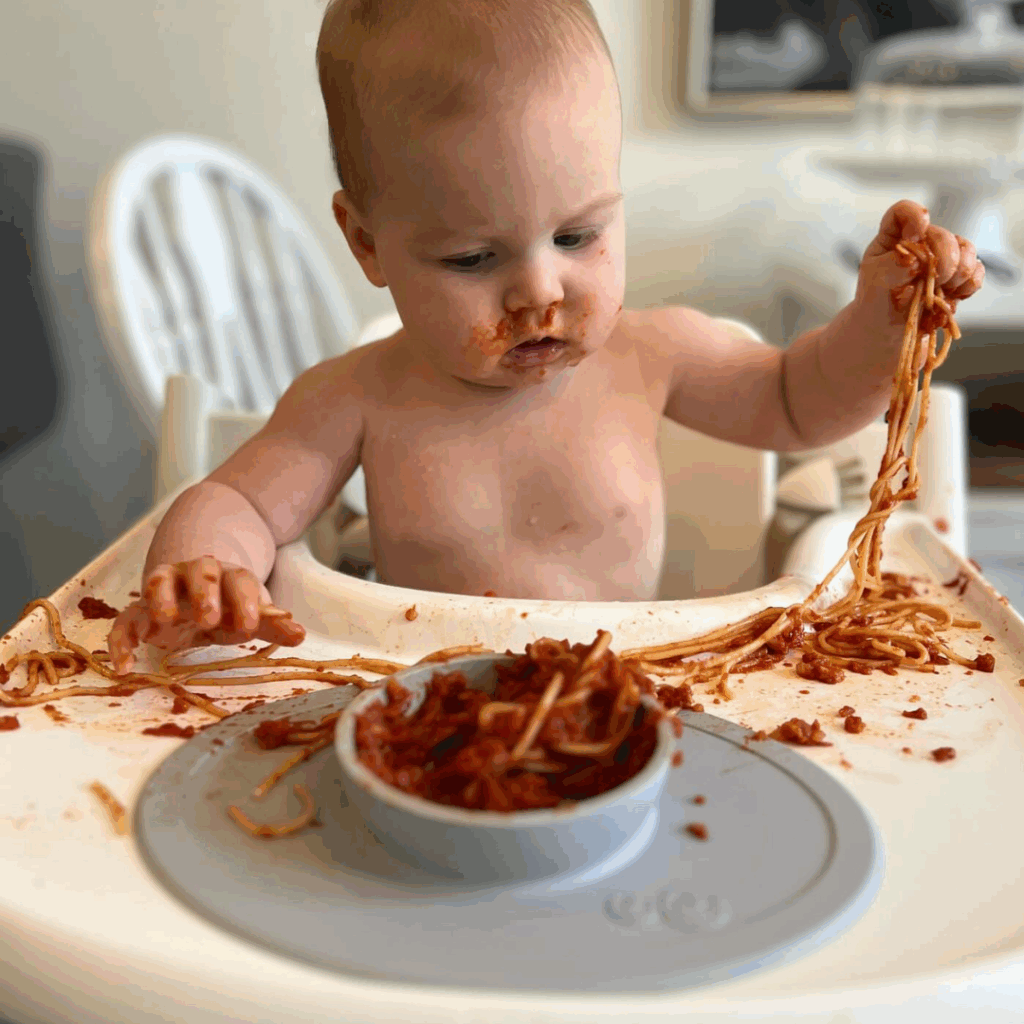
- Removable tray: Removable trays offer versatility for your baby to eat at the table with you when the tray is removed, or to eat in different areas of the home/outside with the tray on.
- Easy to clean with minimal crevices: Look for easy-clean surfaces (chairs without fabric coverings tend to be easier to clean than those with fabric) and stain-resistant straps. Some trays are even dishwasher safe.
- Stable base: Prevents tipping or sliding, especially important for active toddlers.
- Lightweight and maneuverable: Easy to move from kitchen to dining area if needed.
3. Built to Last + Great Value
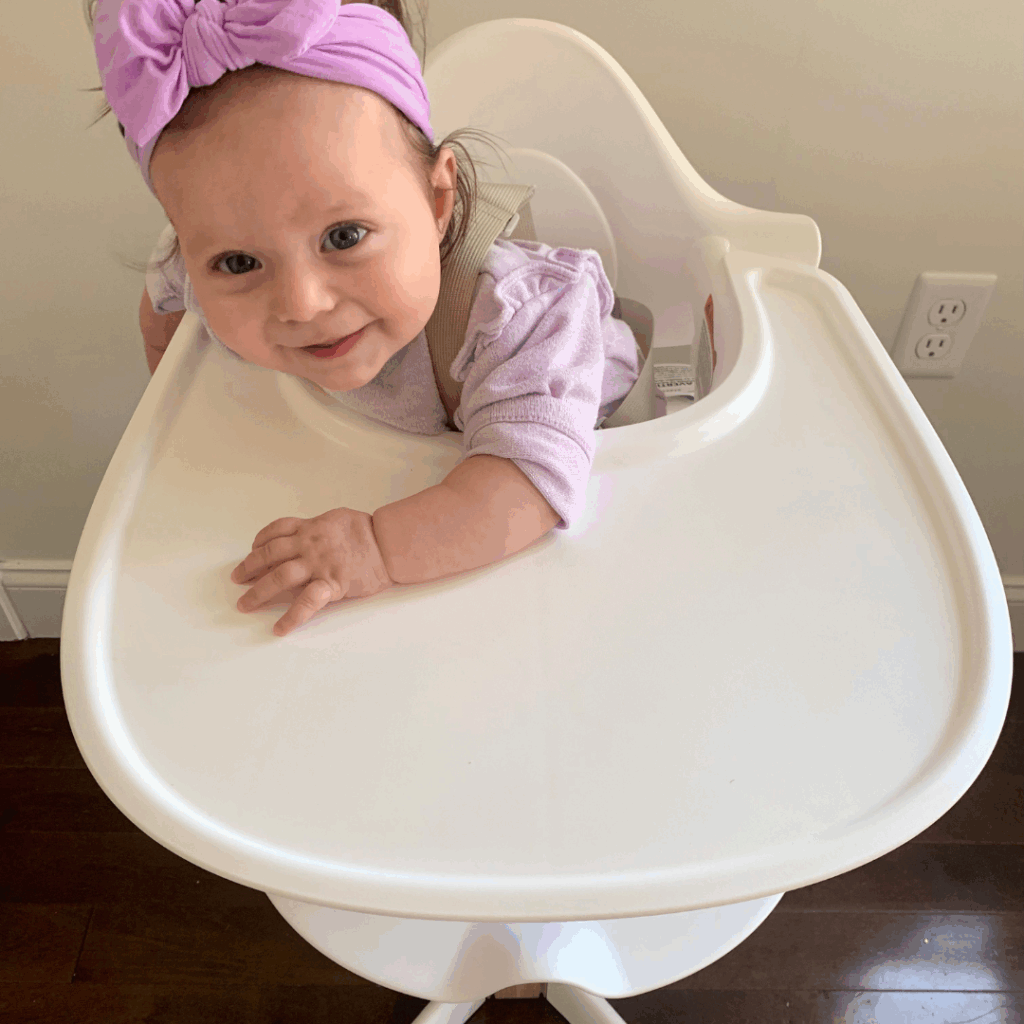
- Grows with your child: Converts to toddler chair, booster, or even youth chair. Note: A child’s feet won’t reach the floor in a regular adult chair until they’re around 8 or 9 years old. If you want your child to stay comfortable (and actually sit through meals), it helps to have a chair that grows with them or offers foot support until their feet can rest flat on the ground.
- Durability: High-quality materials that withstand daily wear and tear.
- Value for price: Weighing functionality, longevity, safety, features, and design.
We know that high chairs can get really expensive. It’s most certainly not about buying the most expensive chair. It’s about getting your money’s worth when weighing everything together at once.
As pediatric feeding experts who work one-on-one with clients on a daily basis, we’ve seen the difference a good highchair makes in how your child actually eats, enjoys mealtimes, and is able to stay safe while doing it. The features we focus on can make the difference between your child wanting to stay for longer at the table and experiencing mealtimes in a baby-led way.
That being said, there is no one perfect chair. We know that you will have specific features that matter more or less to you – like how easily it can be cleaned, moved around and adjusted, the size and the style.
So in this roundup, we’ve taken it ALL into consideration and have come up with the best value options that are feeding expert approved, while giving you options to choose what suits your family best.
What is the 90-90-90 Rule for high chairs?
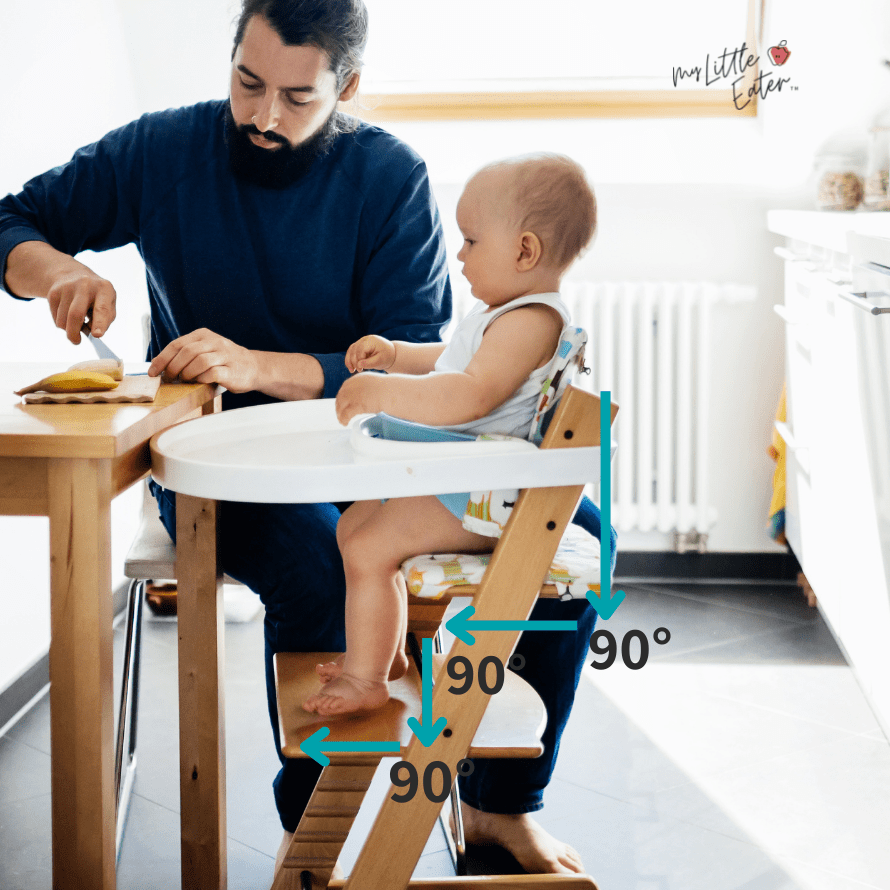
To eat safely and effectively, babies need to be seated with their bodies well-supported — not slouching, dangling, or reclined.
The ideal mealtime posture which is best practice in occupation therapy and pediatric feeding therapy is called the 90‑90‑90 position. This means:
90° at the hips (upright seating, open airway, no slouching or reclining)
90° at the knees (appropriate seat depth so thighs are parallel to the floor)
90° at the ankles (feet flat and supported on a footrest)
This position helps reduce choking risk by keeping the airway open, improves core stability for feeding, supports hand and arm coordination for self-feeding, increases attention and reduces shifting/fidgetiness and fussiness at meals
Our top rated high chairs (feeding expert approved)
Stokke Nomi High Chair
Price: $$$
Best for: The most height-adjustable foot rest/seat depth, tool-free adjustment, light weight, life long chair, modern look

Why we love it:
Adjust to any height to support a true 90-90-90 seating position – Adjust the seat depth and footrest with two knobs to smoothly move it to any height, with no limitations. The seat depth automatically adjusts and aligns itself with the footrest to produce perfect 90 degree positioning at the feet and knees. The back is truly set so your baby can sit perfectly upright.
Easily pulls up to the table to promote family meals – Unique leg design fits neatly under most tables so your baby can comfortably eat right off the table alongside the rest of the family.
Super lightweight design – Lifts onto table edge for floor cleaning and very easy to move around.
Stable base with anti-tilt wheels – Prevents accidental tipping, yet is easy to slide forward and backward as needed to move the chair around.
Grows with your child – for life – No limitations means you can even use it into early childhood and even teenage years by removing the restraints. Quality and build means it’s built to last.
Modern & Stylish – Modern, sleek chair with 7 different color options.
Easier to clean – Smooth surfaces make it easy to wipe down and tray is removable and dishwasher safe.
Max weight: High Chair mode (6-36 months): ~ 15 kg / 33 lbs. “Chair only” mode (after removing baby set & harness): up to 110 kg / ~242.5 lbs
Considerations:
Five point harness can be awkward to fasten and it requires two hands to clip in.
Prone to “bouncing”. While the base is stable and designed to prevent tipping, the lightweight design does allow a bit of bouncing or sliding when an older child pushes against the chair with their body. It’s completely safe — but worth noting if you prefer a chair that stays firmly in place.
Safety straps can be removed and cleaned, but it’s a little more work to remove and re-add them as they need to be threaded through the baby set.
Tray (Amazon US, Amazon CAD) (although not needed if bringing to the family table) and optional cushion (Amazon US, Amazon CAD) need to be purchased separately.
A wide footprint (front-to-back distance of its legs being 27 inches and the side-to-side distance being 24.75 inches)
One of the highest priced high chairs on the market (but built for long-term growth).
Stokke Tripp Trapp High Chair
Price: $$$
Best for: 90-90-90 seating position, grows with child, high quality, smallest footprint
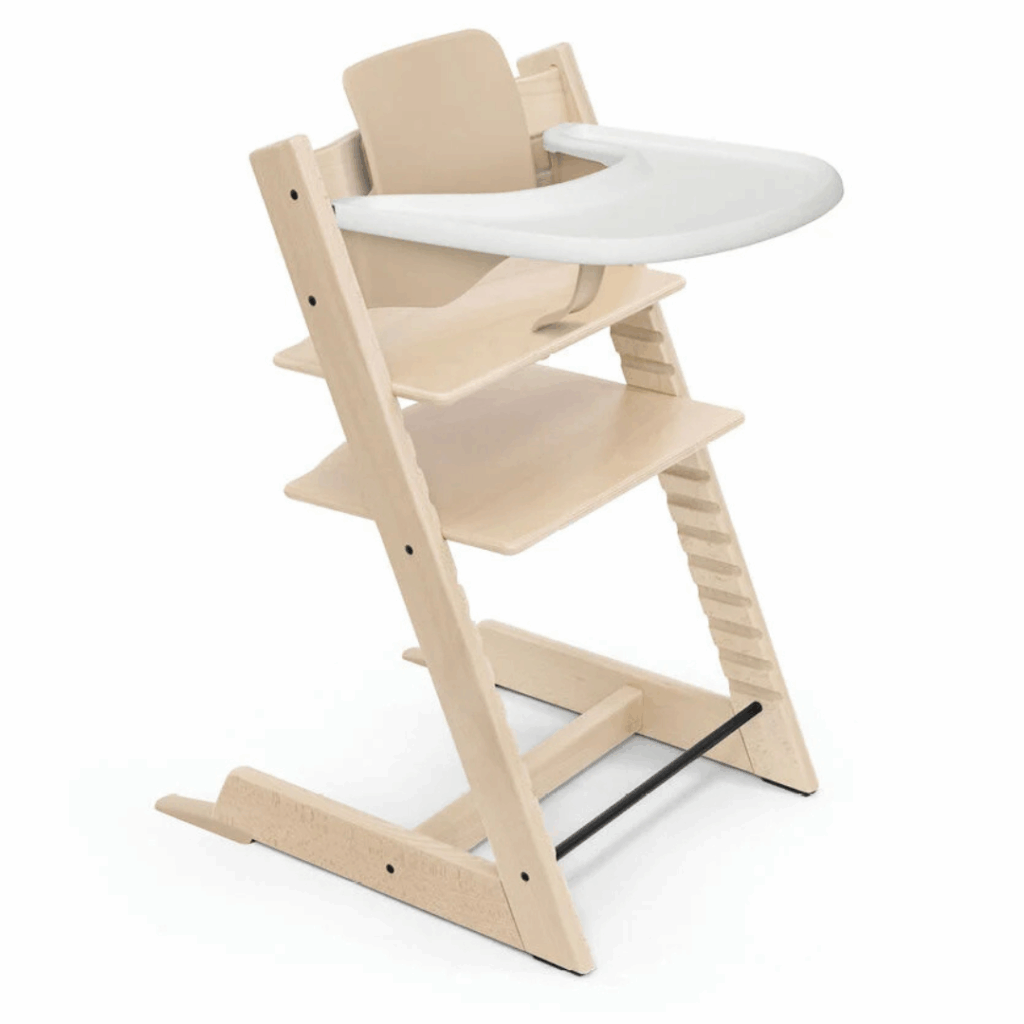
Why we love it:
Supports the 90‑90‑90 position – Adjustable footrest to almost any height (1 inch increments). The seat can also be adjusted forwards or backwards, up or down, depending on your baby’s height. This ensures there isn’t a big gap between baby’s stomach and the tray, that baby’s back is supported against the seatback, and that knees can be exactly at a 90 degree angle. Finally, the adjustable height of the seat ensures your baby’s elbows sit on top of the tray and has free movement of the arms.
Promotes Family Meals – It’s designed to fit right up to your table, making your child a true participant of your family’s social life for meals.
Versatility – Truly a long-term chair that grows with your child and ensures a comfortable and ergonomic seating position for babies and toddlers (and into adulthood).
Extremely stable – Comes with the extended gliders that quickly attach to the legs to provide more stability for younger babies.
Small footprint – This chair has discreet legs you won’t trip on and is narrow enough to fit in like any other dining chair. Excellent for high traffic areas.
Easier to clean – Tray is removable and dishwasher safe, and other surfaces are easy to clean and wipe down.
High Quality Construction – Made from solid wood, the Stokke Tripp Trapp is sturdy, reliable, and built to last for many years.
Color options and design: A multitude of colors allow you to integrate this wooden chair well at the table so it looks like another dining chair and not like a bulky piece of baby gear.
High resale value: Due to the quality and durability of this wooden high chair, the Tripp Trapp has a thriving second-hand market and retains much of its value over time.
High Chair mode (6-36 months): max weight of ~ 15 kg / 33 lbs. “Chair only” mode (after removing baby set): 136 kg / 300 lbs.
Considerations:
Costly – amongst the most expensive high chairs
It’s heavier and not as easy to adjust, as it requires tools to adjust the foot rest and the seat height.
Hard to clean the straps and has many crevices on the legs that food sticks to
Wood paint can chip with time
Suction plates and bowls don’t stick well to the tray due to its textured, non-smooth surface that prevents a strong seal.
Tray (Amazon US, Amazon CAD) and cushion (Amazon US, Amazon CAD) must be purchased separately. Because it’s made to pull up to the family table, the tray may not be necessary for you, unless you want to feed your baby in another location in the house or outside. You can purchase a cheaper tray from a third-party that allows for bowls/plates to suction easily here: Amazon US, Amazon CAD)
Close Runners up
Hauck Alpha+
Price: $
Best for: Budget friendly option to the Stokke Tripp Trapp, grows with child, tool free adjustment, promoting family meals
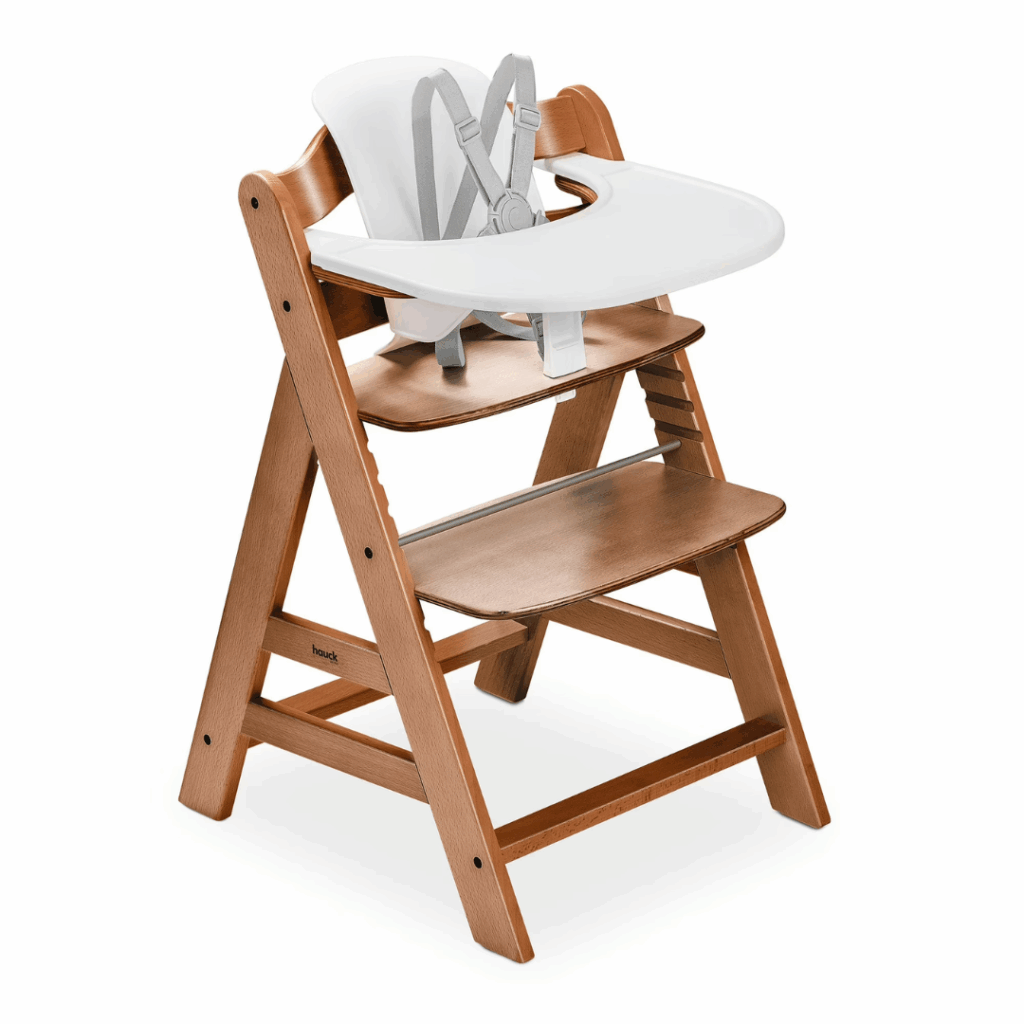
Why we love it:
Ergonomic with modifications – While this high chair supports 90 degrees at the knees and 90 degrees at the feet (1 inch increments), it doesn’t fully support 90 degree positioning at the hips, as the back slightly reclines. Getting the plastic high chair baby seat/infant reducer is a must for safety and better positioning (though it’s only available in Germany or as part of the highchair bundle in the US here). You can also try placing a towel behind your baby’s back and the back of the high chair to keep your baby more upright for safety. It does have an seat plate with an adjustable height to ensure baby’s elbows are above the front bar/attached tray.
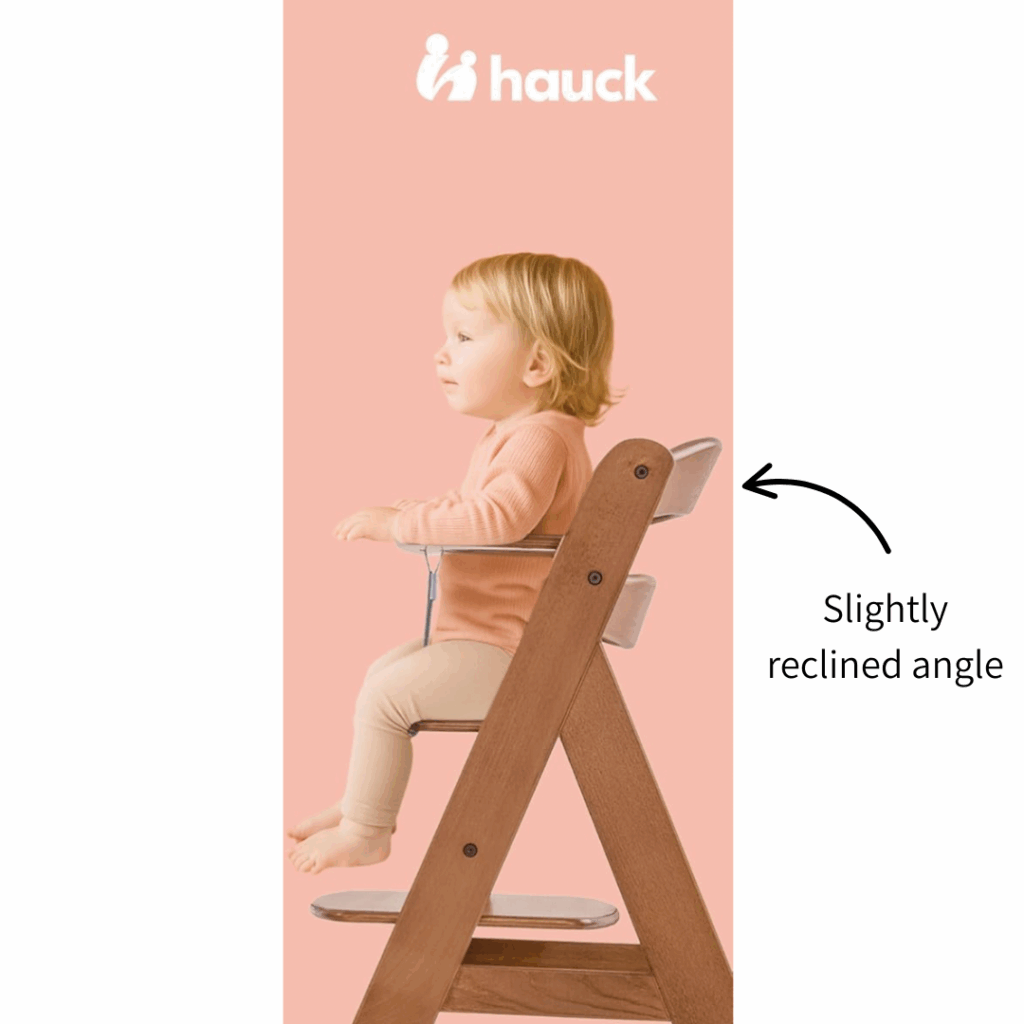
Grows with your baby – From 6 months+ to adulthood. There are two height positions for the high chair and three when used as a child’s chair. See caveat in the section below about footrest limitations.
Adjustable Tray: Only this Huack Alpha Tray has a “table” that adjusts to three positions so it can stay close to your baby’s body (available in the UK and parts of Europe here, available in Canada here, and available in the US as part of the highchair bundle here).
Promotes family meals (when not using a tray) – Can slide right into a standard dining table when there is no tray attached, allowing older babies to join in on family meals (but this may be hard for a smaller baby/younger baby who needs the Hauck Alpha Tray.
Easier to clean – A large removable tray on top of the attached tray is easy to remove and clean. Easy to wipe down other surfaces (except inside of the legs).
No tipping – 5 point harness with plastic sliders prevent chair from toppling over (will push backwards instead).
Sustainable – Made from sustainably made European beechwood.
Stylish – Classic wooden look and comes in 7 different colors.
Considerations:
Not a perfect 90 degree position on the back. This is problematic particularly for younger babies who may not have the core strength to last the entire meal upright, posing more of a choking risk. Purchasing this one piece infant seat reducer is a must for safety and better positioning on the back/sides or wait until your baby is older and can sit up better/for longer. Note that some have complained that the seat reducer then leaves little room to get baby in and out of the highchair easily. Also the plastic one-piece infant seat reducer isn’t compatible with the Huack Alpha Tray that is adjustable.
Like the Stokke Tripp Trapp, the straps hard to clean, food may get stuck in the crevices on the legs, and plates don’t suction well to tray.
Quality isn’t as high as the Stokke (some feedback shows the board can be a little loose after daily use, paint may chips, splintered/dented wood) – however, it’s still very good and the price is justified.
Footplate doesn’t go down as far as the Stokke Tripp Trapp or Nomi highchair after age 5-8, so 90 degrees at the feet won’t be achieved if using as a life-long chair.
Wider Footprint – Although it’s not deep, this chair is has among the widest foot print on the market and takes up more room at the dinner table.
Tray and cushion are sold separately — but for the low price of the high chair and the lower cost of these accessories — it’s still much cheaper than other top contenders.
Can’t get the plastic high chair baby seat/infant reducer in Canada or parts of the UK/Europe (but available in an easy bundle in the US).
Abiie Beyond Junior High Chair
Price: $$
Best for: Cheaper alternative to the Stokke Tripp Trapp (but more expensive than the Hauck Alpha), tool-free adjustment, better for slightly older babies, available in all countries.
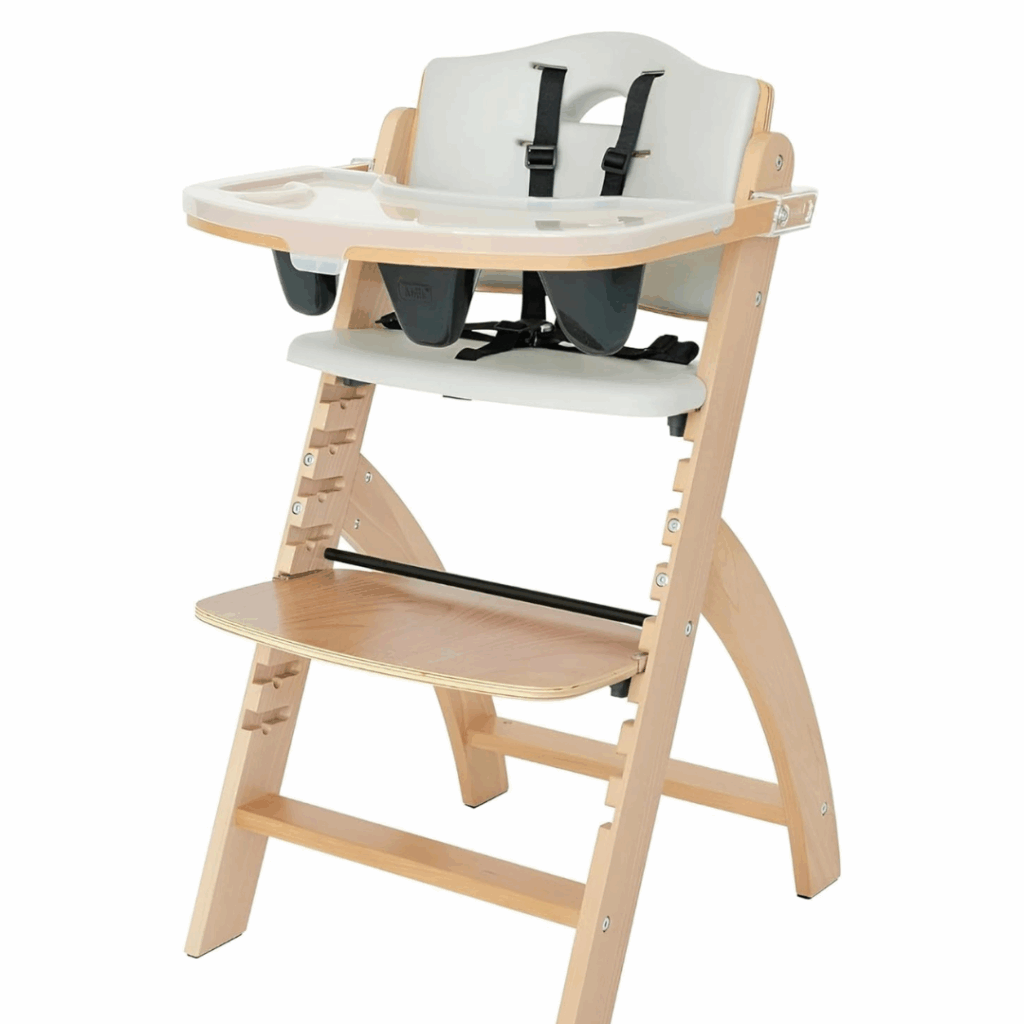
Supports the 90‑90‑90 position – It has an upright seat for safe positioning of the back and hips, and a footplate that can be adjusted tool-free in 1 inch increments (much easier compared to the Stokke Tripp Trapp which needs to be adjusted with tools).
Removable tray cover – Removable tray cover is dishwasher-friendly, offering a convenient solution for busy parents.
Adjustable tray – Two options for tray adjustments as your baby grows – one closer to baby’s body for when they’re smaller babies and one further away as they grow bigger.
Adjustable seat height – Highest level is 24.6″, and it can be adjusted to as low as 10.5″ to accommodate your baby’s elbows being above the tray and having room to move their arms around at various ages.
Relatively easy to clean – Straps have been reported to be easier to clean than the Stokke and it has wipeable plush back and seat cushions that are water proof and don’t absorb any moisture (which can be removed to wash if needed).
Grows with child – This chair carries your child from infancy to adulthood. It can be switched from a high chair to an dining chair in 20 seconds.
Safety – Straps can be set up as a five point or three point harness.
Quality – Made of European beachwood.
Moderate foot print – Very compact in width (17.6 inches) and moderately deep compared to other chairs.
Color options: Comes in a wide variety of colors to choose from.
Considerations:
The footrest is set far in when up high when they are smaller babies, so their heels just touch the footplate (vs. their entire feet laying firmly against the foot rest). As your child grows into a toddler and you adjust the foot rest lower and lower, this self-adjusts.
Doesn’t have an infant bucket seat, so can’t be brought up to the table and used without a tray until baby is older and sturdier.
Tray is small and may not fit many suction plates (they make their own suction plates that fit here.
Be careful of food getting stuck in the grooves of the wooden legs (like Stokke and the Huack Alpha), but also between the cushion and wood frame.
Honorable Mentions
Mockingbird High Chair
Price: $$
Best for: Easiest high chair to clean, easy-to-use harness, adjustable tray positioning, good if you only need a chair into toddlerhood
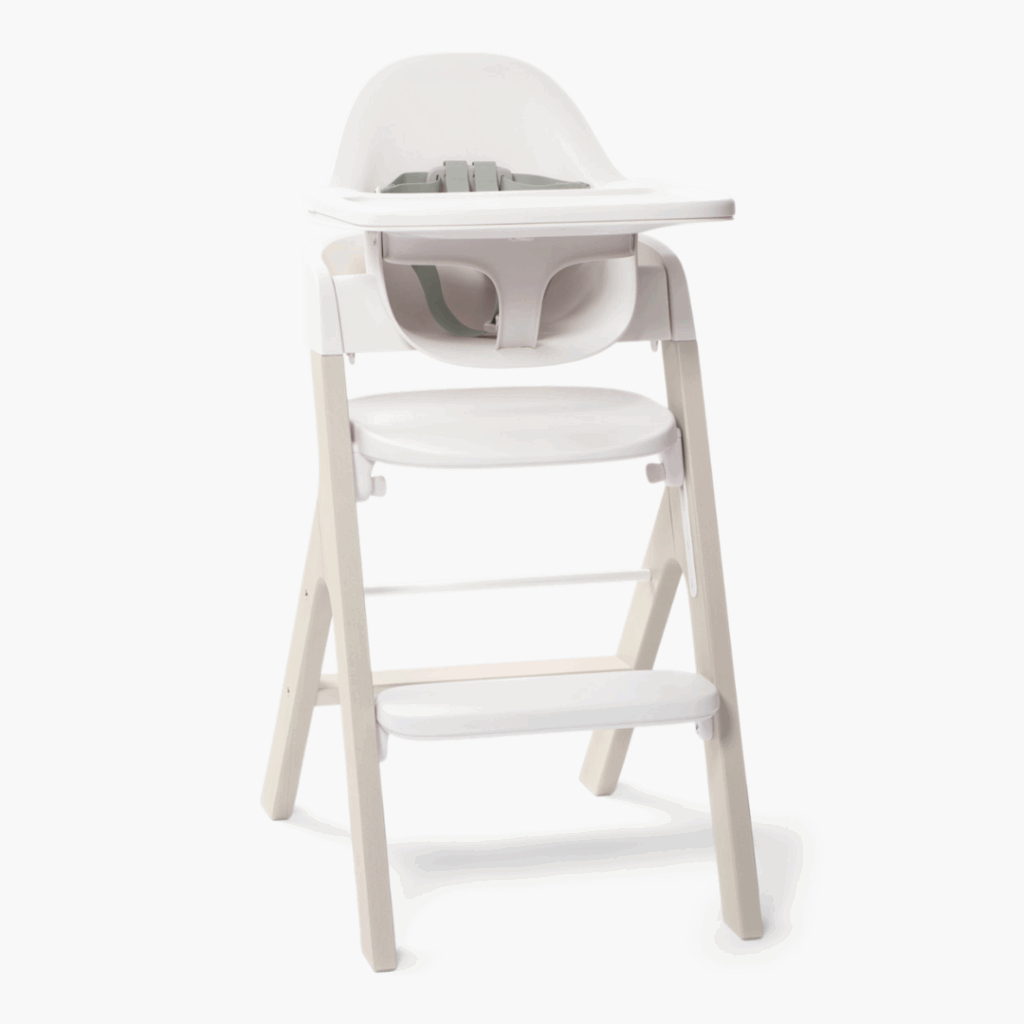
Why we love it:
Easy harness clip – Magnetic five point harness makes fastening and unfastening very easy! Parents consistently mention how intuitive the harness is to fasten — snaps together with one hand even if your child is wiggling.
Seat-back strap holders – Allows you to keep the straps out of the way while you’re putting your child in the seat (or taking them out) – or – while cleaning the seat.
Easy to clean – Has a removable tray on top that can be washed in the dishwasher, while keeping the tray underneath intact and clean. It also features silicone-coated straps that wipe down easily and are the most stain-resistant compared to other chairs on the market.
4 positions for foot rest and seat depth – Can adjust to four positions, making it 90‑90‑90 posture achievable (though some modifications may be required for when baby’s feet can’t perfectly reach the foot rest).
Adjustable tray: Three configurations allow the tray to sit close enough to your baby, to keep food off their lap.
Converts to a child chair: The high chair portion can be removed to chair converts so your older child can sit in it.
Stylish: Comes in 7 different color options to complement a wide range of styles.
Tray: The tray is generally regarded as more suction-friendly than many high-chair trays.
Max weight: Baby-seat/high chair mode: up to 35 lbs (~15.9 kg). Child/regular chair mode: 150 lbs (~68 kg)
Considerations:
Unavailable for purchase in Canada, Europe or the UK.
Adjustable footrest isn’t an option once you convert it to a child seat for toddlers.
Footrest positions may be slightly low or high at times, depending on the length of your baby’s legs so you may be left using stacked books to get the proper foot support.
The high chair is slightly higher than a typical dining chair, so it may not fit the height of all dining tables. In addition, the seat height is not adjustable.
The baby bar/divider between the legs isn’t removable so it may be harder to have room for baby’s legs, especially for bigger or older babies in and out.
While it’s more narrow than most chairs, it’s front to back leg depth take up a very wide footprint (24 inches) — especially compared to the Stokke Tripp Trapp (19.3 inches deep) — so need to consider this in small spaces.
Ikea Antilop
This is an excellent low-cost option (truly) for a highchair to leave at grandparents’/caregivers’ home. It doesn’t meet all our standards for the best high chair as feeding experts, however, with a few inexpensive add-ons/modifications, it can be customized to make it more developmentally appropriate for short term/infrequent use.
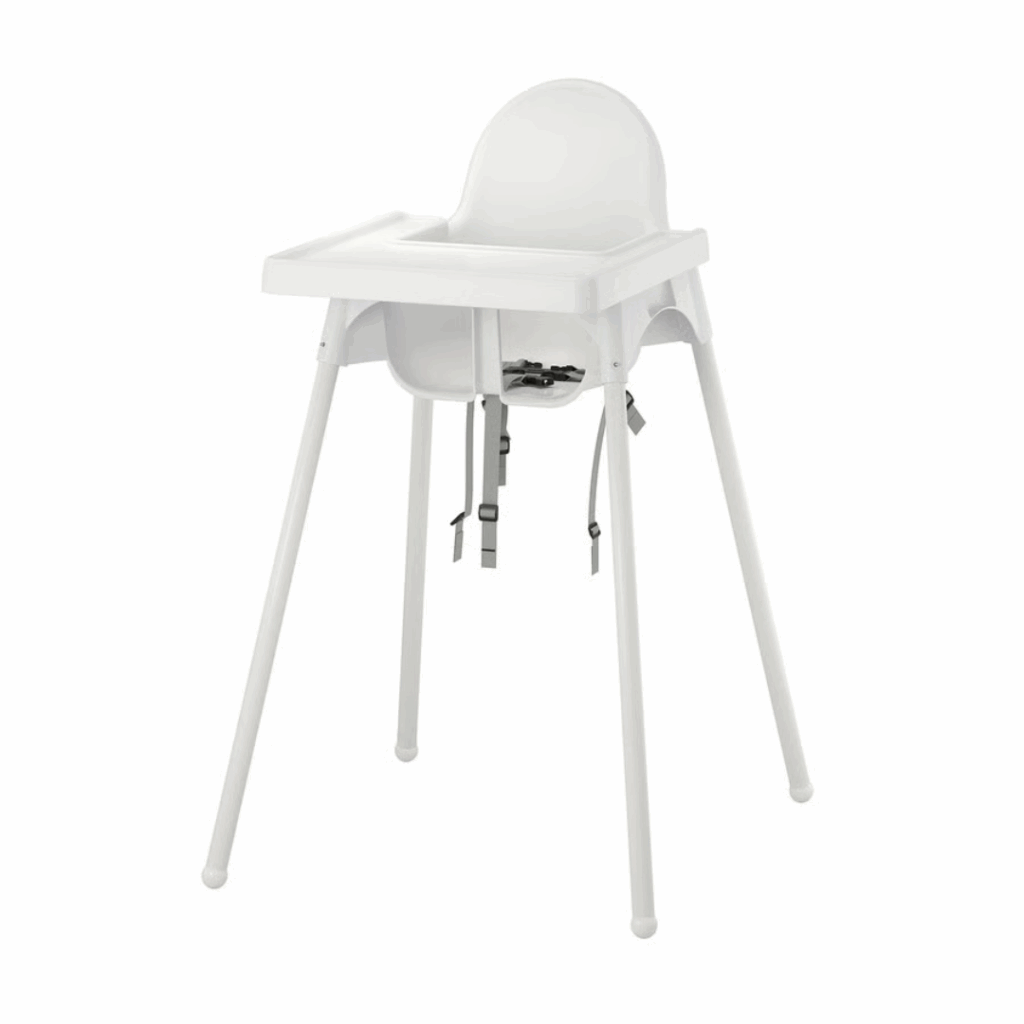
What we love:
Extremely inexpensive (best price on the market)
Simple design that’s easy to clean
Easy to break down and pack up for travel or store away when not in use
Easy to clean
Considerations:
Only has a lap strap (not a five point or even three point safety harness) — which isn’t not recommended for day to day use.
Third-party purchase of foot rest/other accessories required (but very inexpensive and worth it!). We like these adjustable footrests here: Amazon US, Amazon CAD.
Large footprint and easy to trip over the legs.
Can’t be pulled up to the family table to promote family meals
Tray is harder to remove
Tray is not adjustable so big gap that food can fall through
Upseat Baby Floor and Booster Seat with Tray
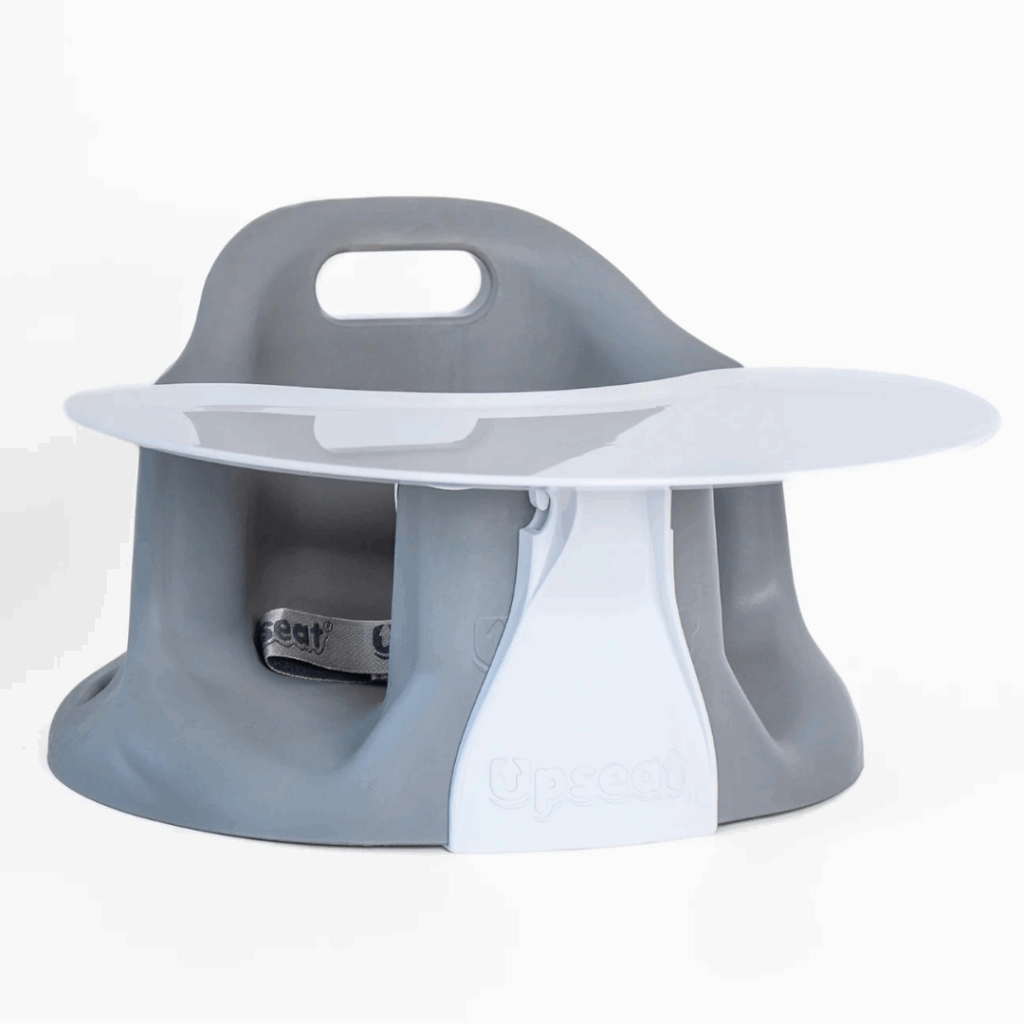
Developed by physiotherapists, this is an ergonomic seat that encourages an upright posture and is safe for developing hips. It has an attachable tray that allows you to use this for safe feeding when needed. As feeding experts, our opinion is that this is best for:
What we love:
Gives an option for babies who are medically instructed to start solids and are unable to sit upright in a highchair without leaning forward, backwards or to the side.
Great to use in the interim of a few weeks/months before they are able to sit in those highchair options that do not come with infant buckets/crotch dividers.
When travelling, eating outside, and taking to a caregiver’s house.
Can be used as a booster seat in early toddler years.
Considerations:
No footrest (babies legs stick out straight)
Max weight limit is 30 lbs or 13.6 kg.
High chairs that didn't make the cut
Cybex Lemo 3-in-1
Price: $$$
Best for: 90-90-90 seating position even into adulthood, tool free adjustment, easy to wipe and clean
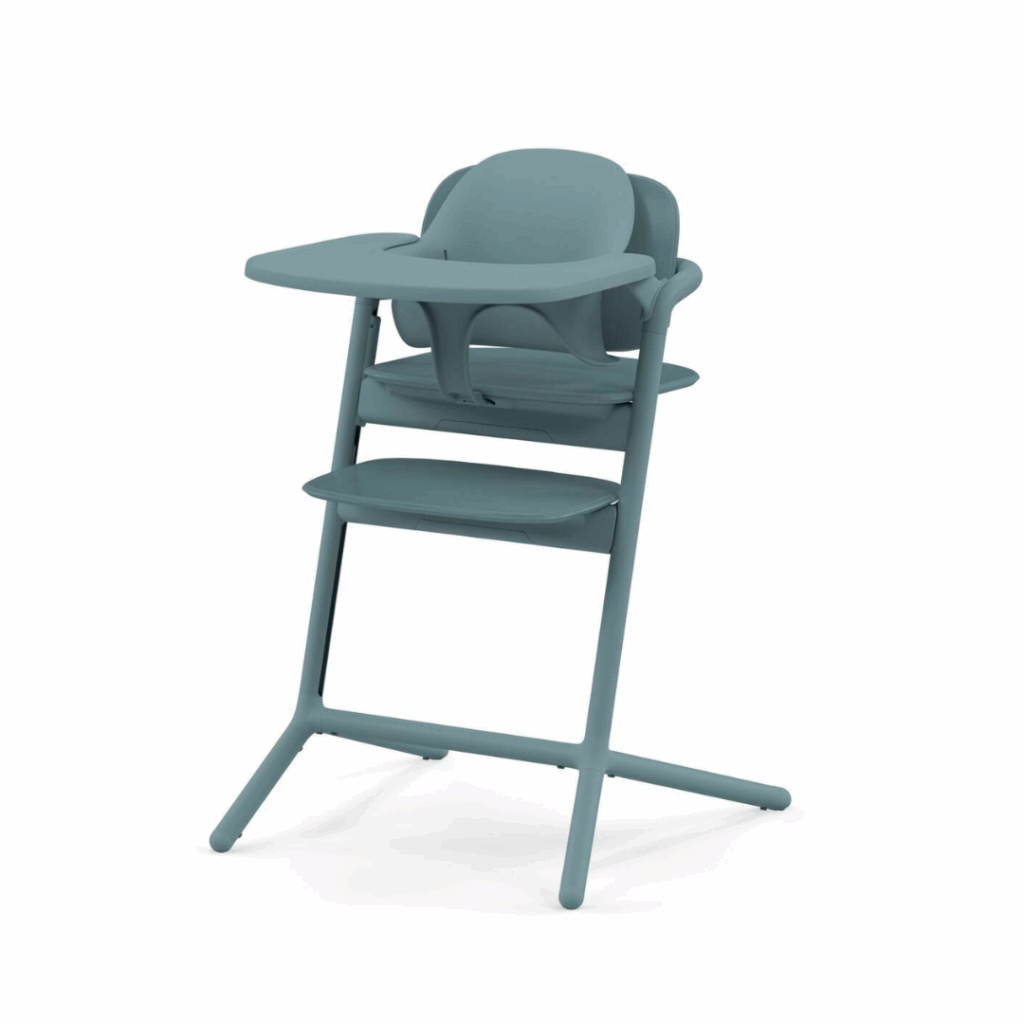
Why we love it:
Supports the 90‑90‑90 position – Tool free adjustment of the chair height and depth to optimize 90-90-90 seating position at the hips, knees and feet – no matter the height of your baby or toddler! Completely adjustable to any position with no restrictions (like the Nomi).
Grows with child – Grows with baby into toddlerhood, early childhood and adulthood. It converts to a proper toddler and then adult chair that still maintains flexibility in the foot rest and seat depth, so that the 90-90-90 seating position is truly maintained for all ages.
Sleek, modern, minimalist design – with 6 different color options
Easy to clean – Clean lines and no crevices make this chair very easy to clean and wipe down.
Safety – The front legs have silicone foot caps to prevent slipping and keep the chair stable, while the back legs are fitted with castors so that if your child pushes away from the table, the chair gently rolls back instead of tipping.
Tray and infant bucket are included – No separate purchases are required for these.
Considerations:
It’s an expensive chair option – though again – it’s meant to be a forever chair (think homework and crafts with a fully adjustable footrest and seat depth to keep older children from fidgeting). Pro tip – the price varies depending on the color.
The 5 point harness (which is a must for safety) must be purchased separately and is another added expense.
This chair has an even wider footprint than the Stokke Nomi high chair, which makes it harder to place around a table amongst regular dining chairs.
Heavier than the Nomi highchair when comparing light and modern designs. The Lemo is 19.6 lbs compared to the Nomi at 7.7 lbs.
The tray is removable but is too large for most dishwashers (so handwashing is recommended which many not be a problem for some).
Overall verdict – While this has excellent function, so does the Nomi High Chair — but the Nomi is slightly cheaper, lighter, and narrower, with a tray that is dishwasher safe. If you like this, we recommend the Nomi High Chair as a potentially better alternative.
Lalo High Chair
Price: $$
Best for: Unsure
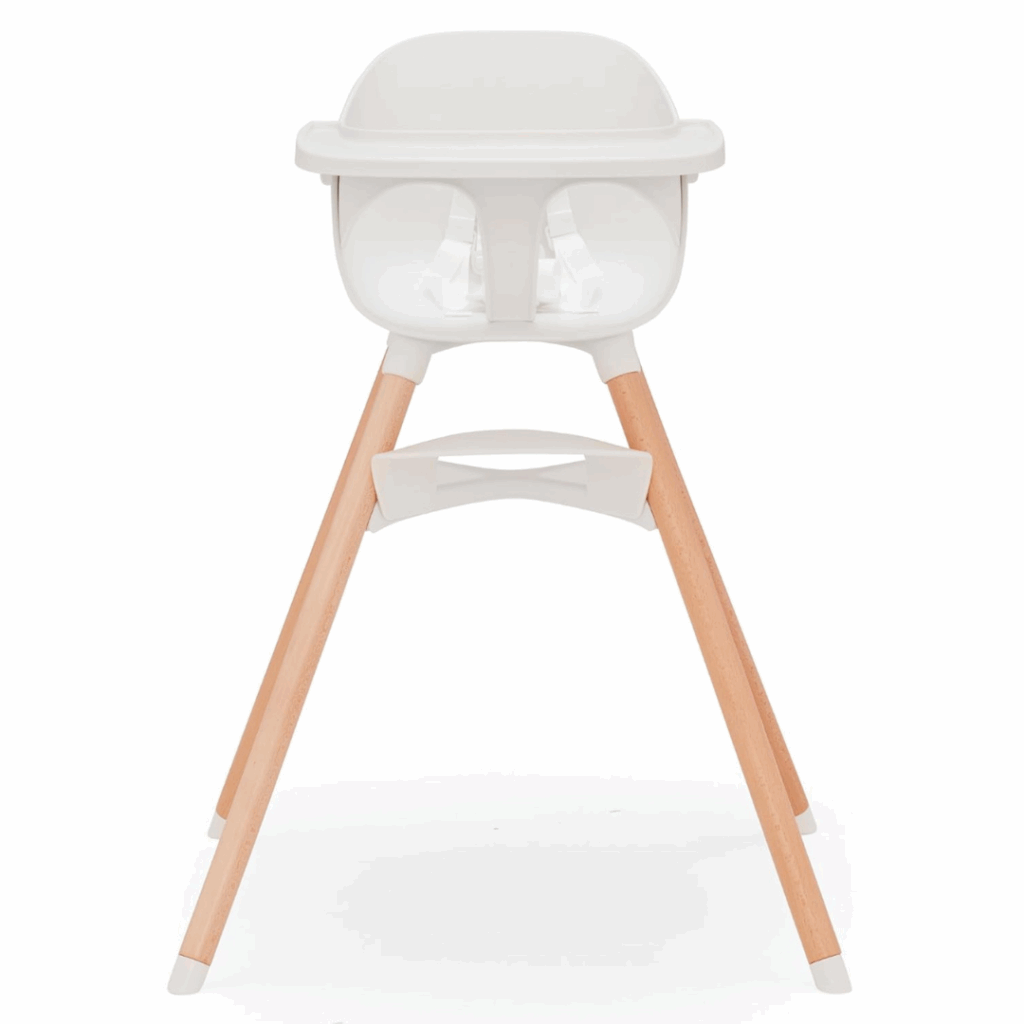
Pros (can’t say we love it):
- Footrest – There is technically an “adjustable food rest” that can be flipped over to produce two heights (but with many limitation – see considerations below).
- Easy to clean – Nylon straps are easy to wipe and clean and are removable for a more thorough cleaning. You can purchase a machine washable cushion (cotton fabric) or a wipeable vegan leather cushion separately.
- Lightweight – Easy to pick up/move around the house
- Color options: 5 color options
Considerations:
- It’s not ergonomic. It’s unlikely to find a good fit with the foot rest for your baby’s height most of the time. The shape of the footrest doesn’t allow for stacking of books or other adjustments should your baby’s feet not reach the footrest. Even when the foot rest can be reached, it’s shallow and most times only baby’s heel can rest on it (not lay flat and be used for significant support). It’s also more of a bucket seat when you don’t have the infant insert add-on, which may prevent your baby from sitting upright and may risk a slightly reclined position. You could experiment with a rolled up blanket behind baby’s back to help this.
- Extremely large footprint – legs take up lots of space in both directions which isn’t great for small spaces and the wooden legs can be tripped over.
- Infant insert needs to be purchased separately.
- Smaller tray size that may make it harder to fit certain suction plates.
- Straps are difficult to take out to clean and need some force/fiddling.
- Doesn’t grow with your child – good for up to 3 years of age (max weight of 30 lbs).
Overall verdict – Way too expensive for minimal function and many modifications.
UPPAbaby Ciro
Price: $$
Best for: Bib holder, adjustable tray, promotes family meals
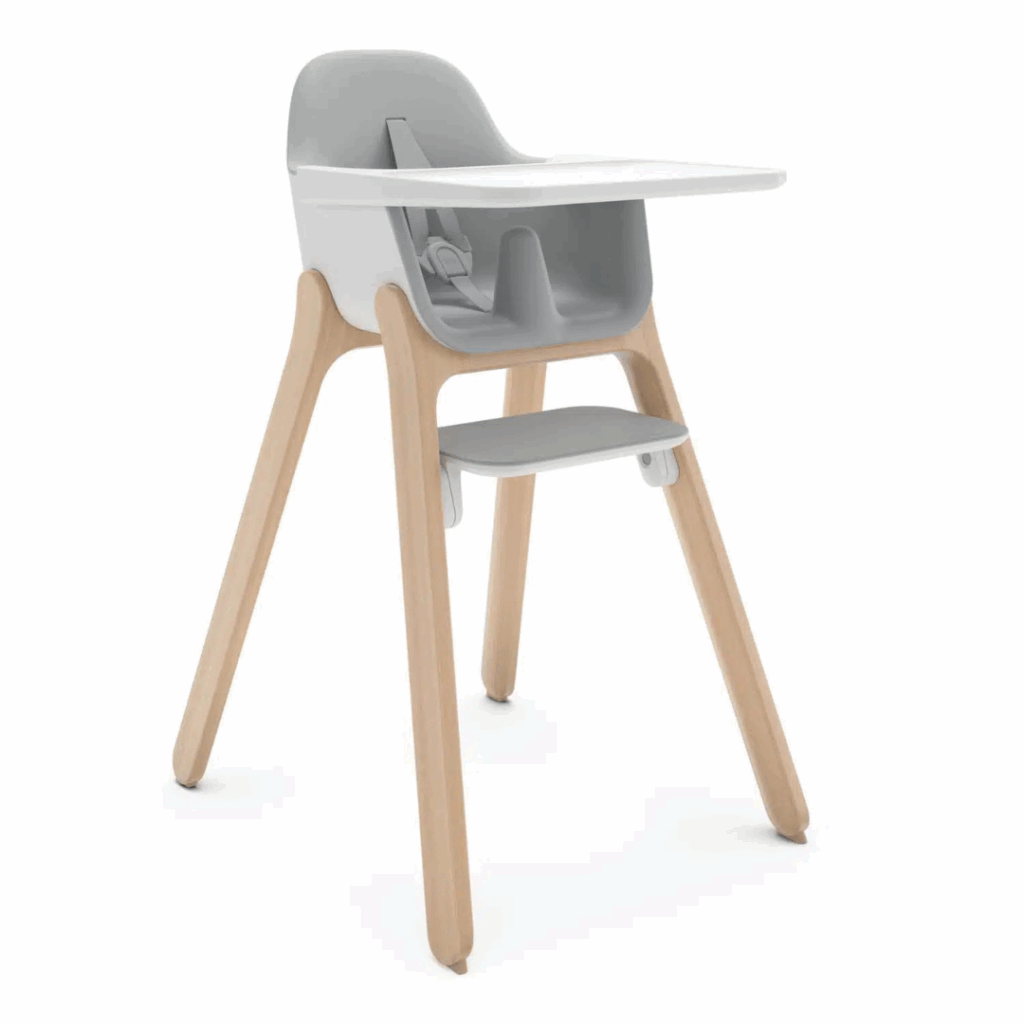
Why we love it:
Bib holder on the back: A hook on the back that allows you to hang your child’s bib(s).
Adjustable tray: Three tray positions allow the tray to sit close enough to your baby, to keep food off their lap. The tray is also easy to get on and off and is a large size.
Footrest – This is another dual position adjustable food rest (with a better and more functional shape than the Lalo high chair but still requires modifications).
Promotes family meals – The height of this high chair tray fits directly over the table so baby can eat with you.
Easy to clean: The seat is one seamless piece of plastic so its very easy to clean, the straps can be removed and washed, and the removable tray is dishwasher safe.
Floor friendly feet: Allow you to move the highchair around in the house without scratching your floors
Considerations:
Adjustable footrest only adjusts to two heights via a rotating mechanism so you will likely have to add boxes/books to reach your baby’s dangling feet.
The seat is deep and large so small babies would have a hard time supporting their back/sides.
Seat height is not adjustable.
Infant insert seat cushion for extra support is sold separately.
Can only be used up to 3 years of age.
It deep in size (front to back) so it will stick out more from the table/wall area in case that’s an issue for small spaces.
Limited color options available.
Overall verdict – For around the same price as the Mockingbird high chair, it has fewer features, needs more adjustments and doesn’t grow with your child.
How to know when baby is ready for a high chair
Most babies are developmentally ready for solid foods—and the use of a high chair—around 6 months of age. But instead of focusing on age alone, it’s more important to watch for signs of readiness, such as:
Strong head and neck control
Ability to sit independently in an upright position for short periods
Good trunk stability
Curiosity and interest in food
Using a high chair too early can lead to unsafe feeding and negatively impact your baby’s ability to explore and eat successfully. That’s why the first thing to look for in a high chair is a fully upright seat that supports your baby’s body in a stable, secure way.
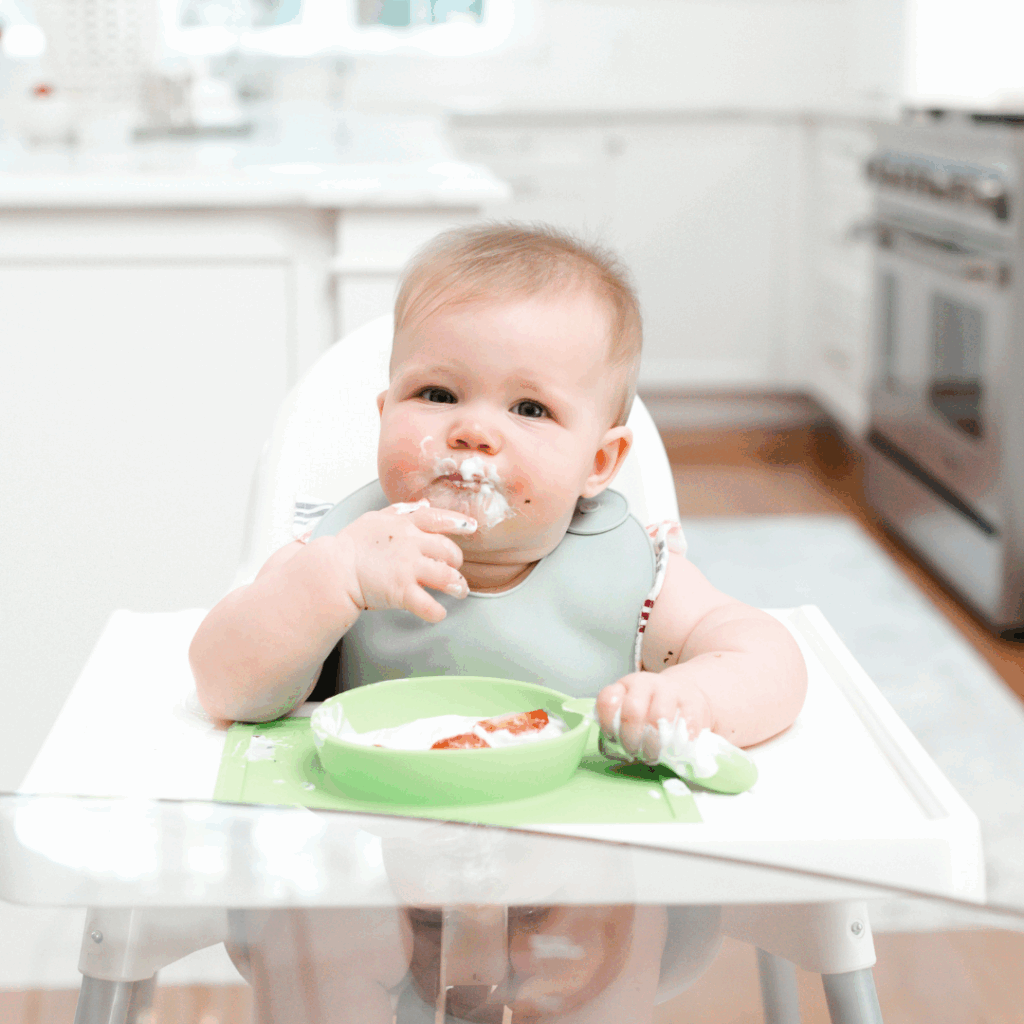
How to make modifications to a high chair
Even the best highchair sometimes needs a few tweaks to properly support your baby, depending on their size. The goal is always the same: hips, knees, and ankles at 90°, feet supported, and the tray or table at belly-button height. If your baby doesn’t look stable or can’t reach comfortably, here are practical ways to adjust things at home:
If your baby can’t reach the tray/table/food:
- Check their seat height. The tray should line up roughly at belly level, not up at the chest or armpits. This allows them to rest their elbows while reaching for food, prevents straining, and makes it easier to practice self-feeding skills. If you have a high chair that has adjustable seat height – perfect! Otherwise, boost your baby’s hips with a firm surface (like a thin cushion or folded blanket under their bum).
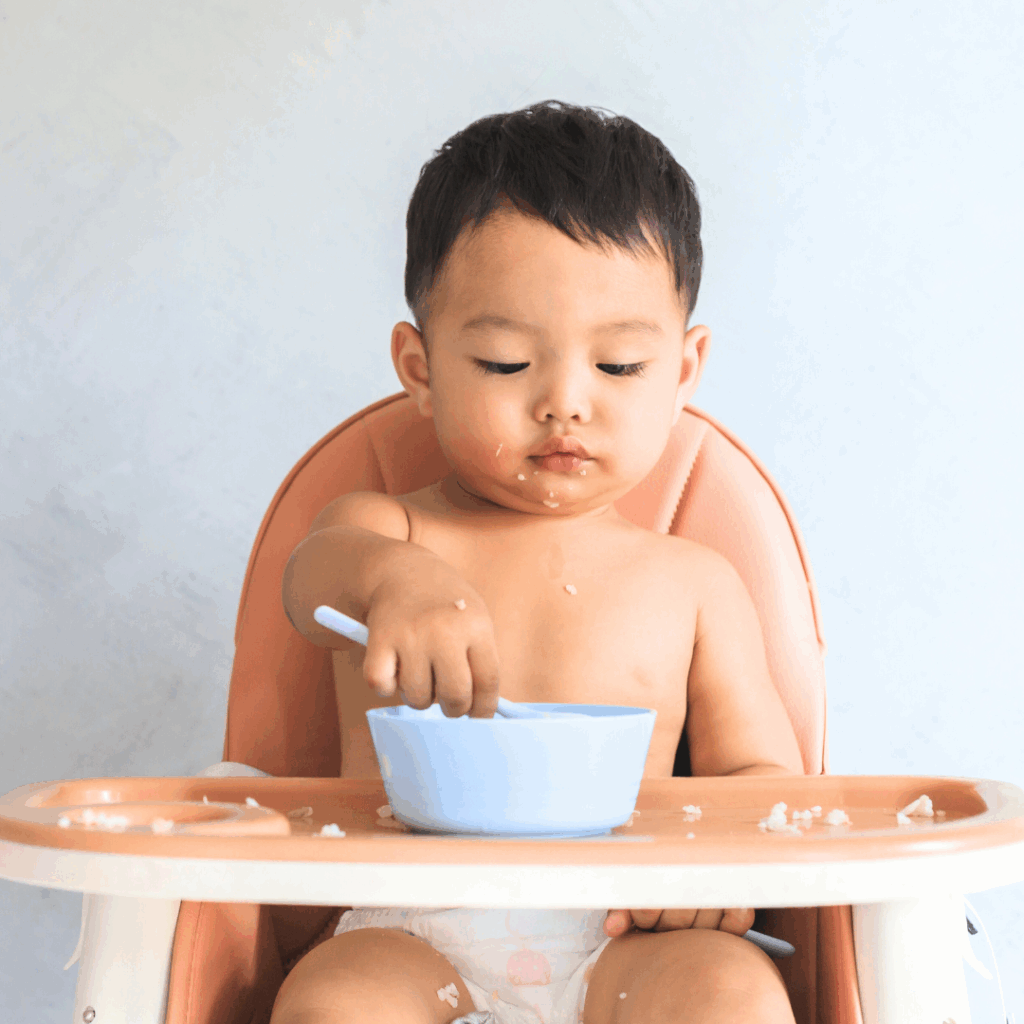
Watch how they sit with the boost — their forearms should be able to rest on the tray, and they should have the stability to reach food without leaning forward awkwardly. If they can’t stay upright even with this adjustment, it may be worth waiting a week or two before starting solids until their core strength improves.
Check their seat depth. If your baby’s arms are too far away from the tray/table, adjust the seat depth closer to the baby’s tray if your high chair allows. Alternatively, adjust the tray closer to your baby if your high chair allows. If you don’t have either of these features, place a folded towel behind your baby’s back to prop them a bit more forward.
If your baby leans or slouches in the seat:
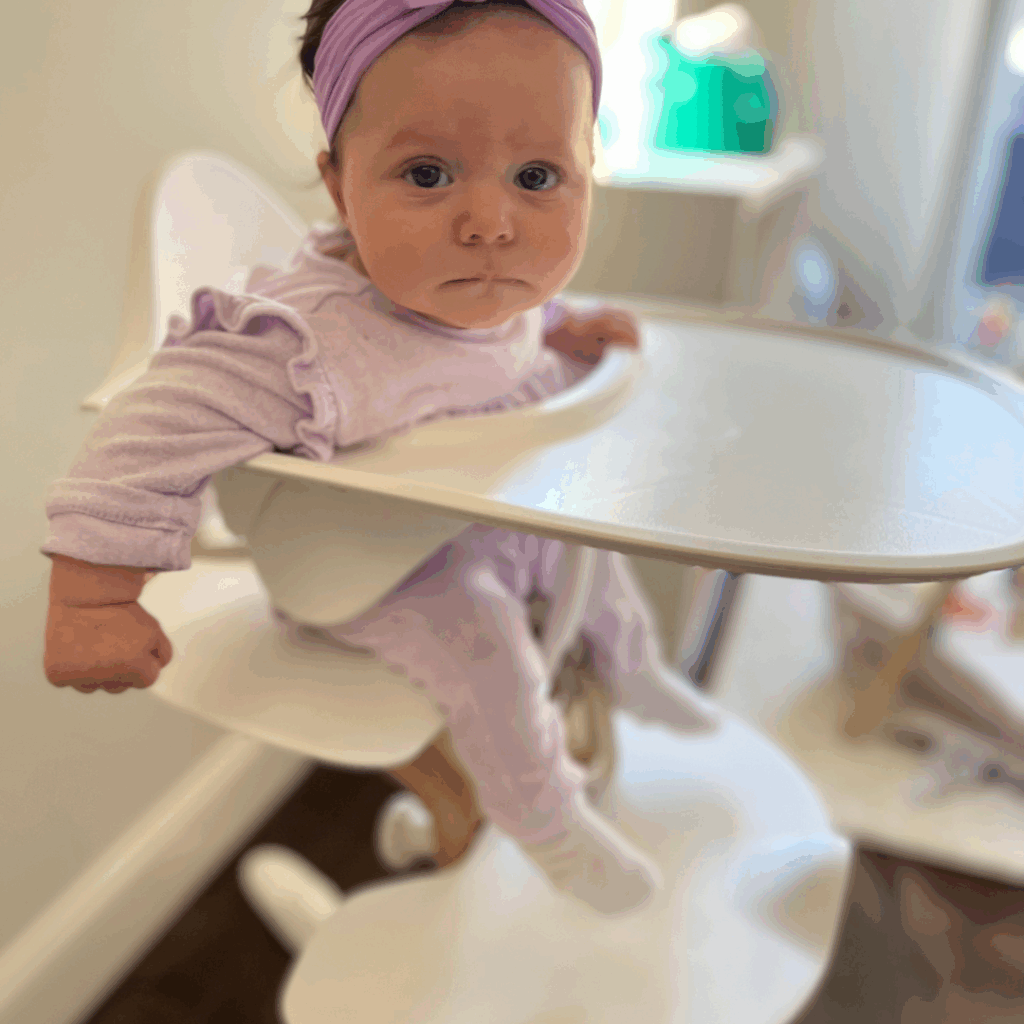
- Some chairs have wide seats, which can make smaller babies wobble or tip to the side. Use rolled-up towels or small blankets tucked snugly along your baby’s hips and sides to fill the space and keep them centered. Place one towel behind their lower back if they need more upright support — this helps them avoid sliding or arching. Remember, if your baby needs lots of props to stay upright, it’s a sign their body may not be quite ready for highchair feeding yet.
If your baby’s feet don’t reach the footrest:
First, scoot your baby’s bottom forward so their legs dangle freely at the edge of the seat. This sets them up to use the footrest properly. Use the strategies mentioned above to support baby’s back in an upright position when doing this.
If the footrest is too low, raise it by securing something sturdy on top (like a yoga block, cardboard box, or a taped-on book).
If the chair doesn’t have a footrest at all, create one by attaching a cut pool noodle, an exercise band, or a fabric sling between the chair legs. The goal is to have their knees bent at 90° with the soles of their feet pushing against a stable surface — even if that surface is a simple DIY hack.
By making these small adjustments, you’re creating a secure, stable foundation for eating — and that stability translates into better focus, safer swallowing, and happier mealtimes for everyone.
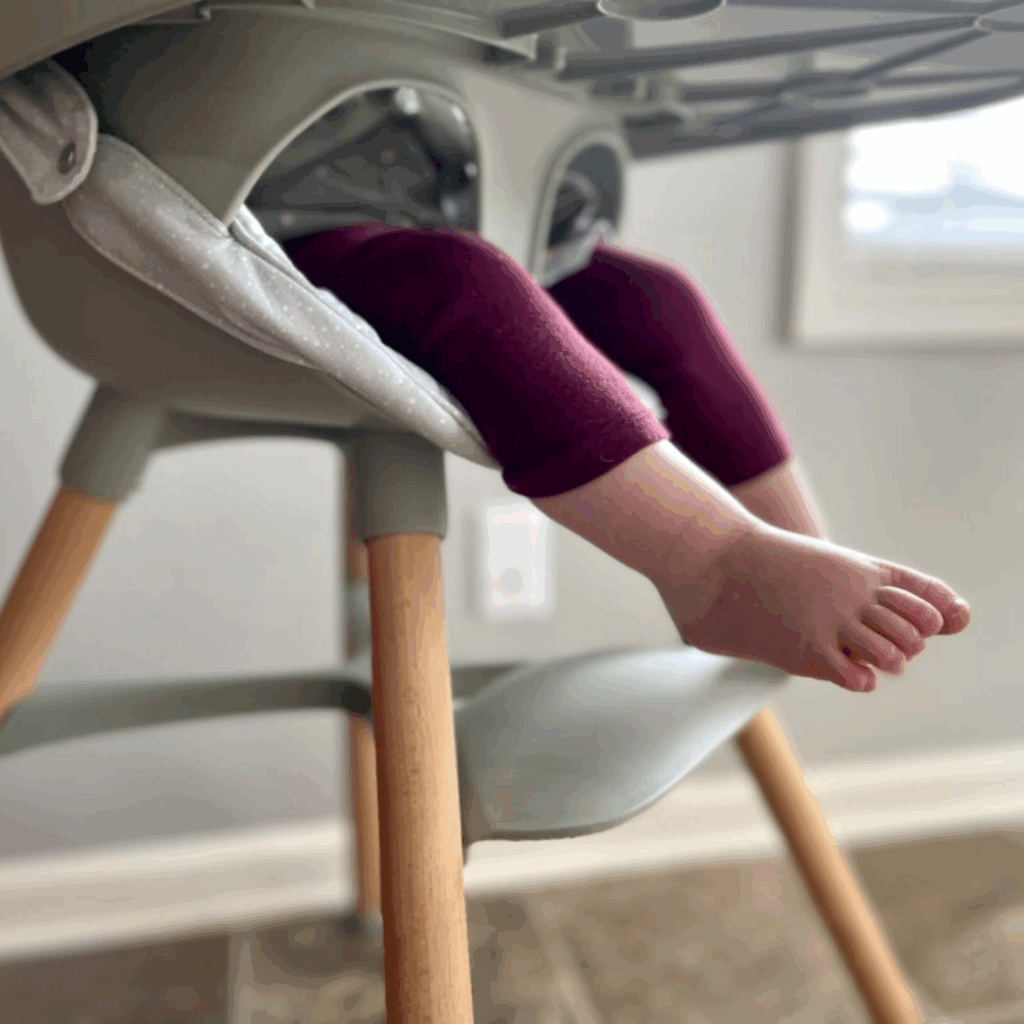
Can I feed my baby without a high chair?
Technically, yes — but it’s not what we recommend. Here’s why:
Safety first: When babies sit in a highchair, they’re upright and stable, which keeps their airway open. On your lap, it’s harder to keep them steady and in a safe position.
Independence matters: A tray gives your baby a space to explore, play, and eventually feed themselves — whether it’s purees or finger foods. On your lap, they miss out on that hands-on learning.
Clear visibility: Choking is silent. If your baby is facing the table while sitting on your lap, you may not see their face clearly enough to act quickly in an emergency.
So while lap-feeding can work in a pinch (say you’re out at a restaurant without a highchair), the safest and most supportive option is always a secure seat with a harness and tray in front of your baby.
Do I have to strap my baby into the high chair?
The safest way to prevent falls is to always use the harness exactly as the manufacturer recommends. Straps aren’t just an optional extra — they’re a critical safety feature.
Recent data shows that more than 14,000 high-chair injuries were treated in U.S. emergency rooms in 2023 (up from about 9,800 in 2014). High chairs are now one of the top nursery items contributing to home injuries.
Studies show a large percent of child injuries associated with high chairs are related to falls from improper use of straps. Sometimes the tray was clipped on, but the belt or crotch strap/harness wasn’t being use, which means even “just sitting” becomes risky.
For young babies just starting solids, harness straps are essential. They:
Keep baby upright and stable when their posture is still developing.
Support safe swallowing and chewing by preventing slouching or leaning.
Prevent falls when babies are wiggly, tired, or playful.
A five point harness (like a car seat) is ideal at this stage. The shoulder straps stop your baby from leaning forward or sideways out of the seat and allow them to focus on learning new skills without extra movement.
As babies grow into toddlers, the harness becomes less about posture and more about keeping an active child contained at the table. Once toddlers can climb and stand, straps help prevent them from:
Rocking dangerously in the chair
Standing up mid-meal
Attempting to tip the chair
When can I transition my child out of the high chair?
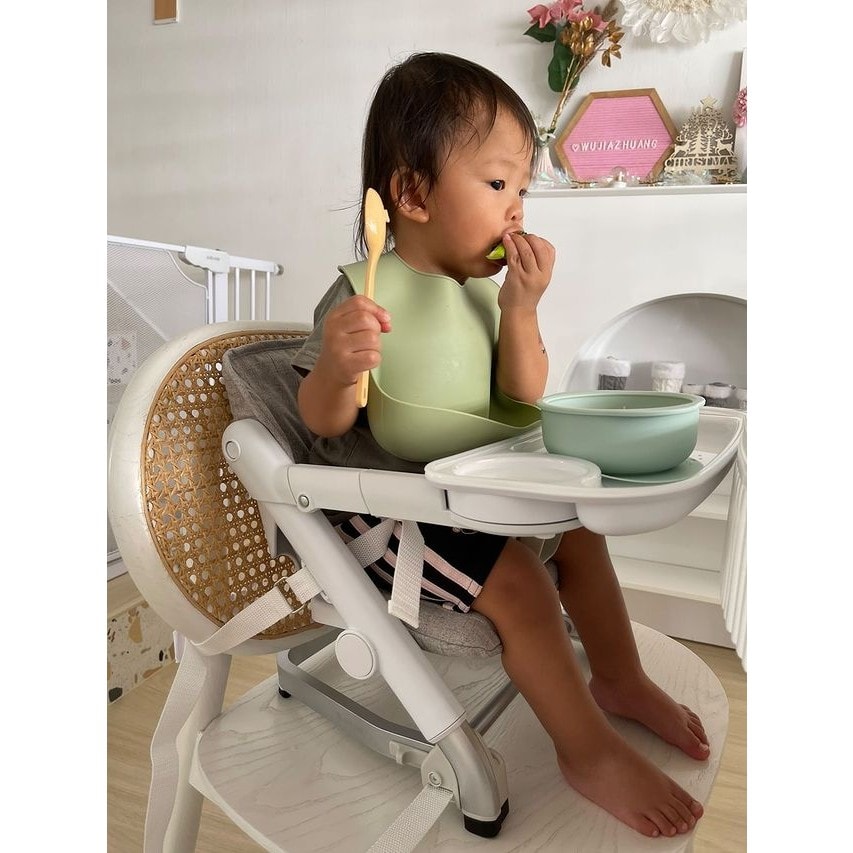
Most toddlers can sit in a regular chair by about 12–15 months. But here’s the thing: just because they can doesn’t always mean they should — at least not full-time.
At 15–18 months, many toddlers still need the extra support of a high chair (or a toddler chair/booster with a footrest) to reach the table comfortably and stay in a stable position. Without that support, they’re more likely to wiggle, slide, or lose focus on the meal. Not to mention, increased choking risk.
And let’s be honest — behavior plays a big role too. Toddlers love their independence, which often means hopping up and down from the table if given the chance. A high chair with a harness can help keep them in one spot long enough to actually eat. This makes mealtimes calmer, safer, and less stressful for everyone.
So here’s our advice:
If your toddler is happy in their high chair, keep using it. Many kids will sit comfortably until 2 or even 3 years of age if you have an ergonomic high chair that grows with your child, and there’s no rush to move them out.
Once they outgrow it, choose a supportive toddler seat or booster seat with a harness that keeps their feet planted and body positioned upright (if you don’t have a high chair that converts to an ergonomic toddler chair).
Before skipping support altogether, wait until your child can sit safely in an adult dining chair with their feet firmly on the ground (or on a stool/booster). Depending on their height, that may not happen until well into the school years — often around 8-9 years old.
Bottom line: keeping toddlers in a supportive seat isn’t “babying” them. It’s giving them the safest, most successful foundation for eating — and saving parents from chasing them around the dining room at every meal.
Here are our next best options for booster seats if you don’t end up choose a high chair that grows into a toddler chair:
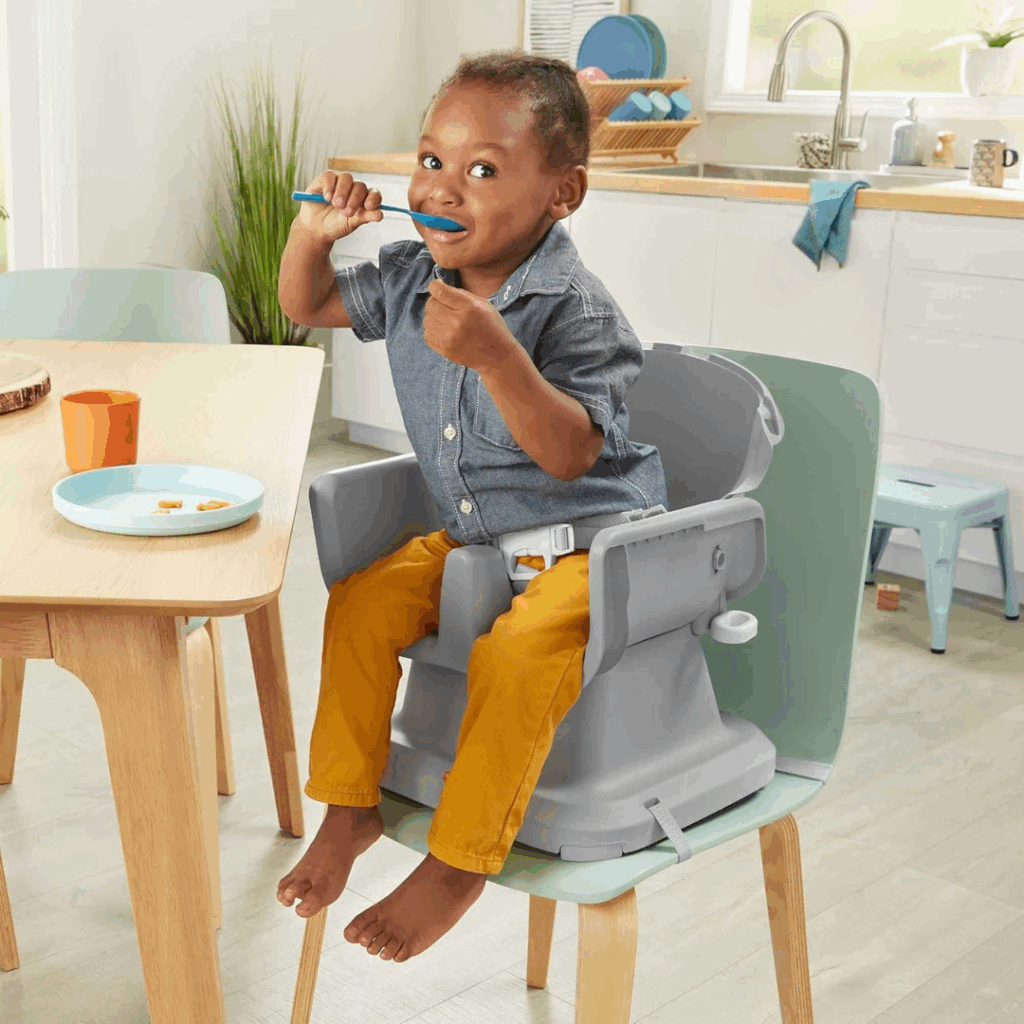
Fisher Price Toddler Booster Seat (Canada) and Fisher Price Toddler Booster Seat (US)
OxoTot Perch Booster Seat (Canada) and OxoTot Perch Booster Seat (US)
Ingenuity Smart Clean Booster Seat (Canada) and Ingenuity Smart Clean Booster Seat (US)
Overall, choosing a high chair isn’t just another baby-gear purchase — it’s an investment in your child’s safety, comfort, and long-term success at the table. The right high chair helps your baby sit securely in the 90-90-90 position, keeps their airway open for safe swallowing, and sets them up to learn how to self-feed with confidence. It also makes mealtimes calmer for you, since your little one is supported, contained, and more likely to stay at the table.
At the end of the day, there’s no single “perfect” high chair. The best choice is the one that balances proper ergonomics with features that fit your lifestyle — whether that’s easy-to-clean straps, a compact footprint for a small dining space, or a design that grows with your child for years. We hope this guide helped you sort through the noise.
If you’re feeling overwhelmed about starting solids and you’re not sure where to begin, join our FREE workshop – How to start solids: A realistic first week of feeding your baby. This workshop is for parents ready to feel confident and prepared to start solids—without all the guesswork.
Learn exactly what to feed, when to feed it, and how to do it—step-by-step—with expert guidance from pediatric dietitian, Edwena Kennedy. Plus, get a FREE 5 day meal plan just for attending!
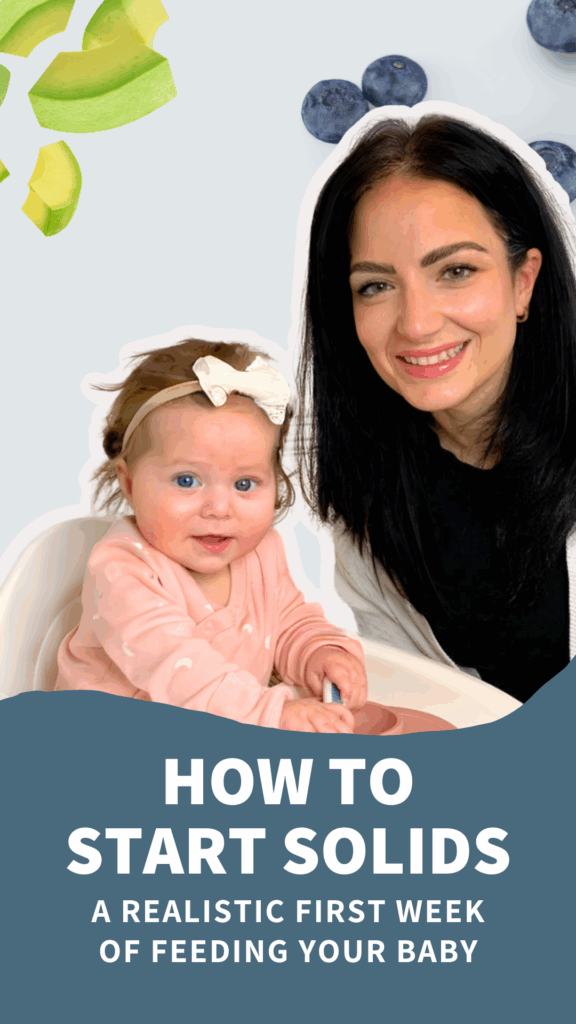

Edwena Kennedy, RD
Founder and lead Registered Pediatric Dietitian at My Little Eater Inc., creator of The Texture Timeline™, and mom of two picky-turned-adventurous eaters.

Edwena Kennedy, RD
Founder and lead Registered Pediatric Dietitian at My Little Eater Inc., creator of The Texture Timeline™, and mom of two picky-turned-adventurous eaters.

